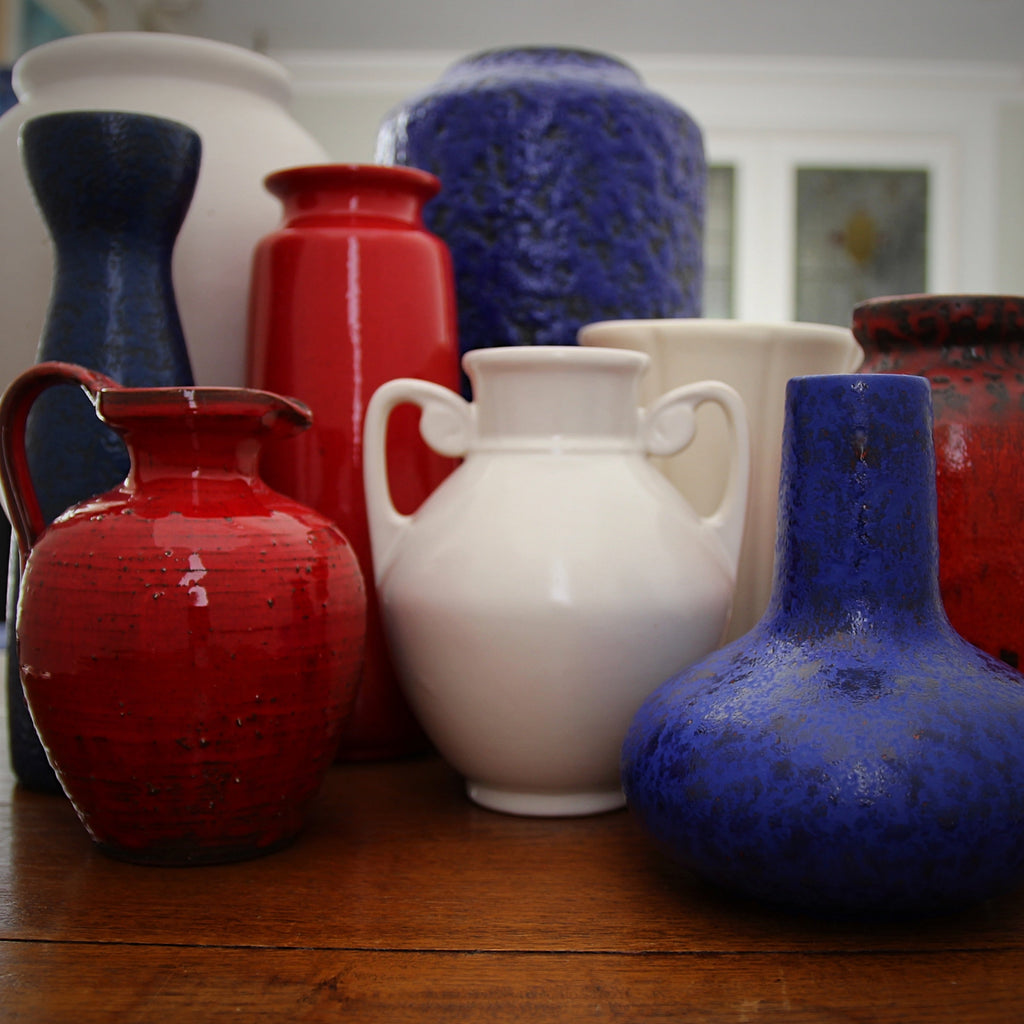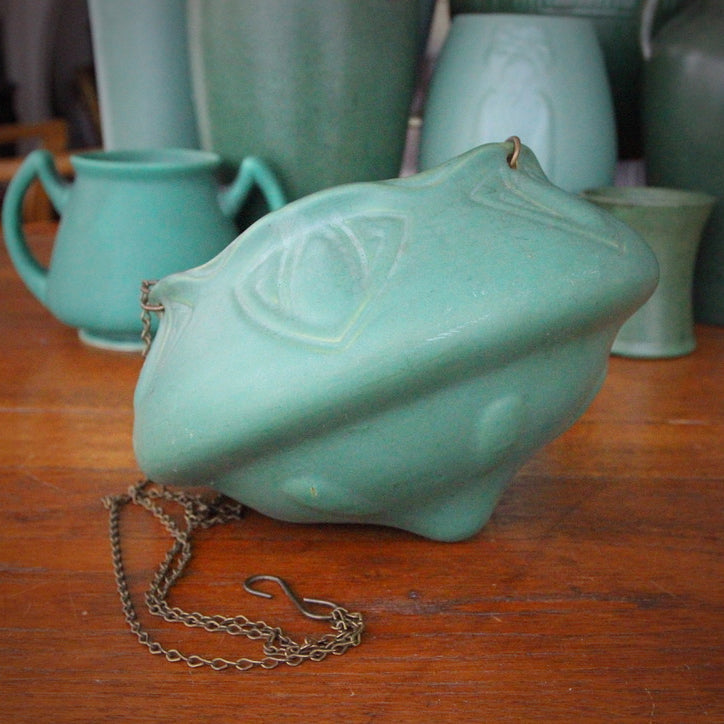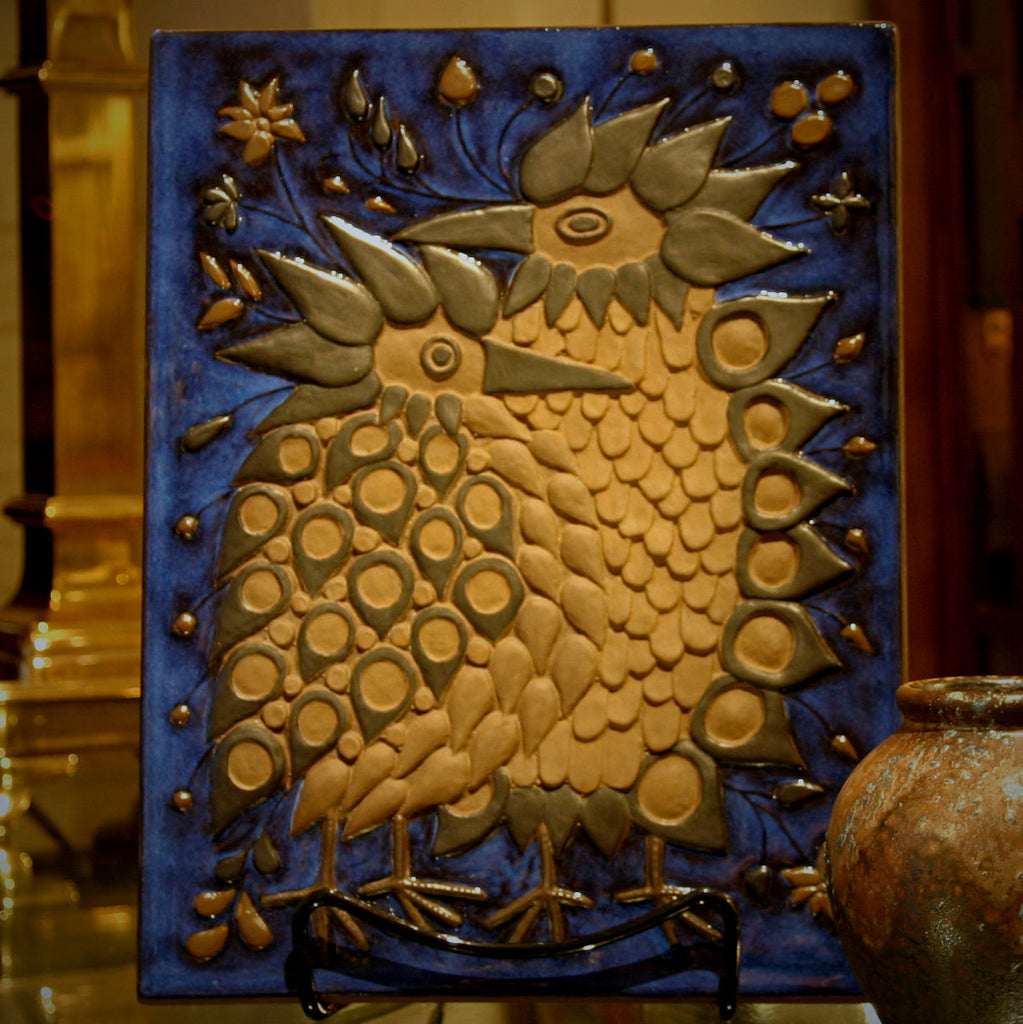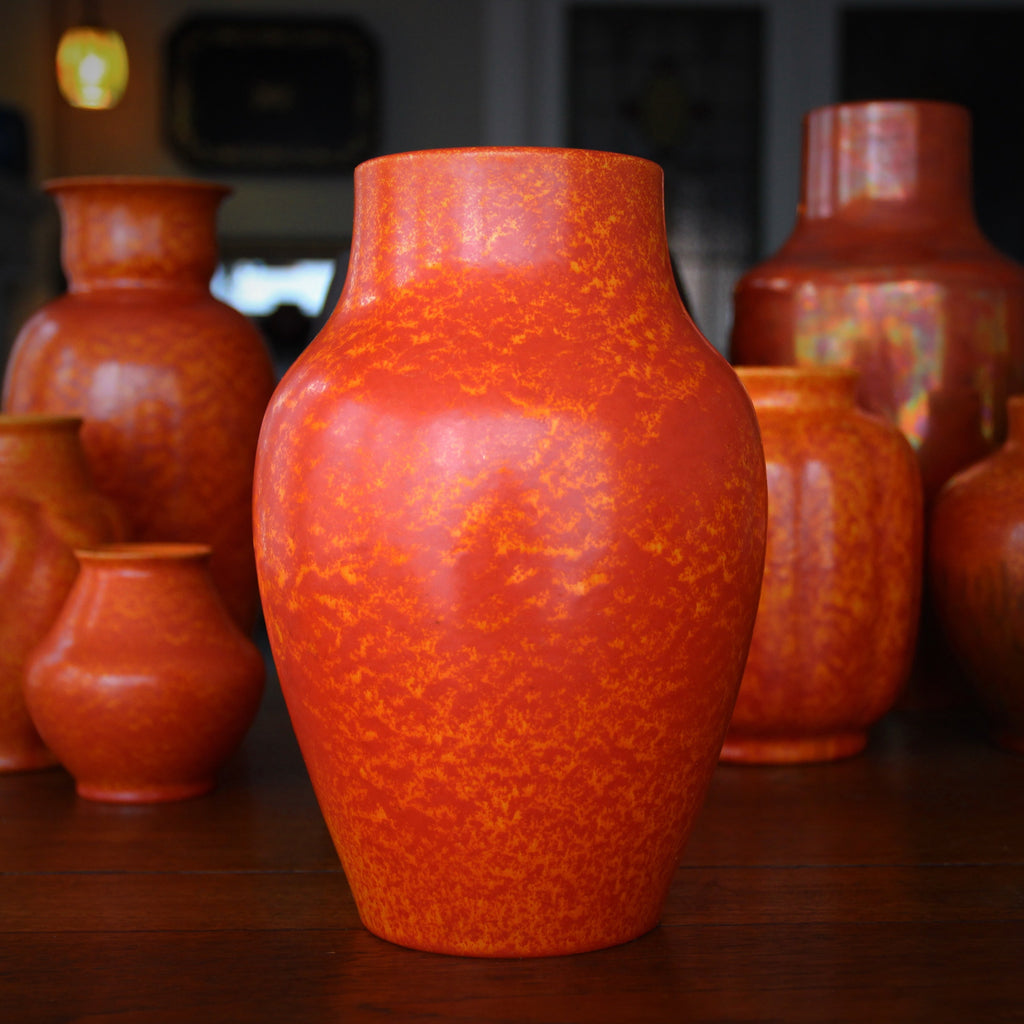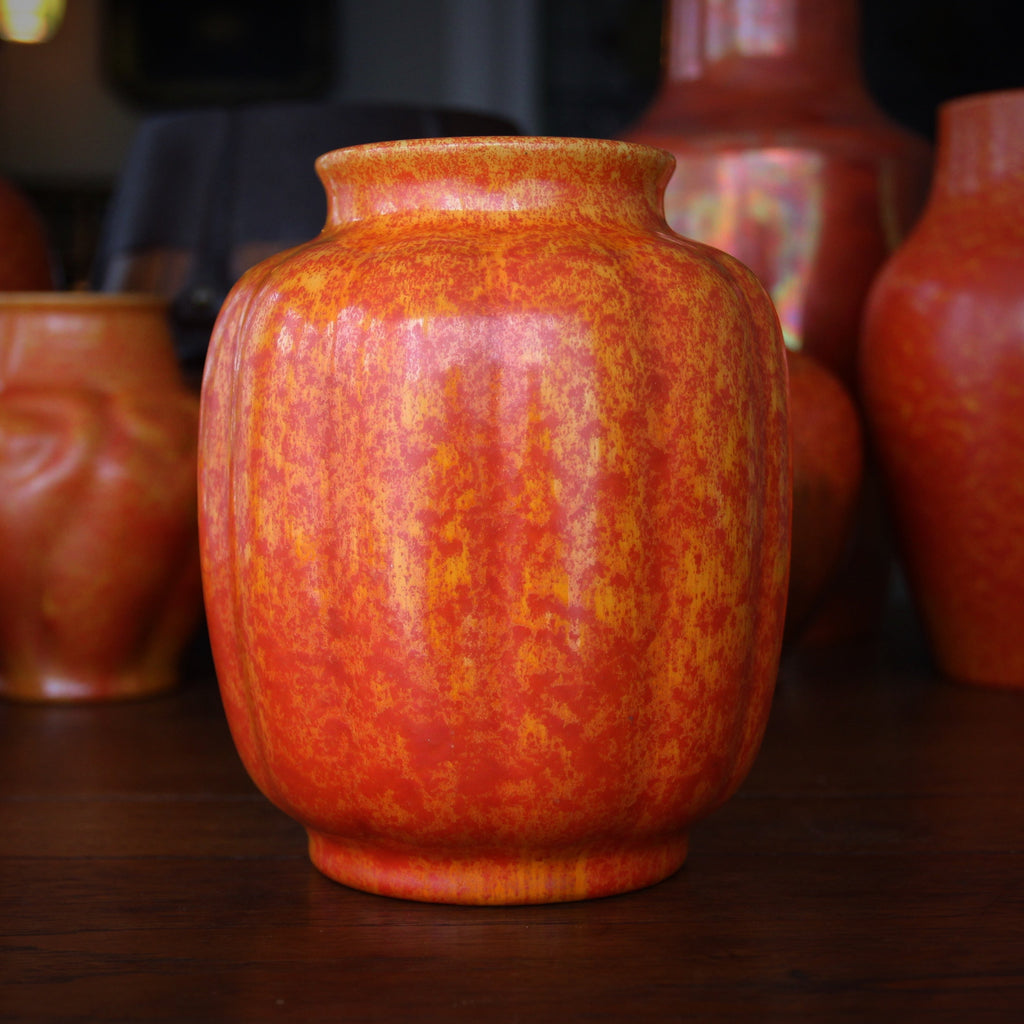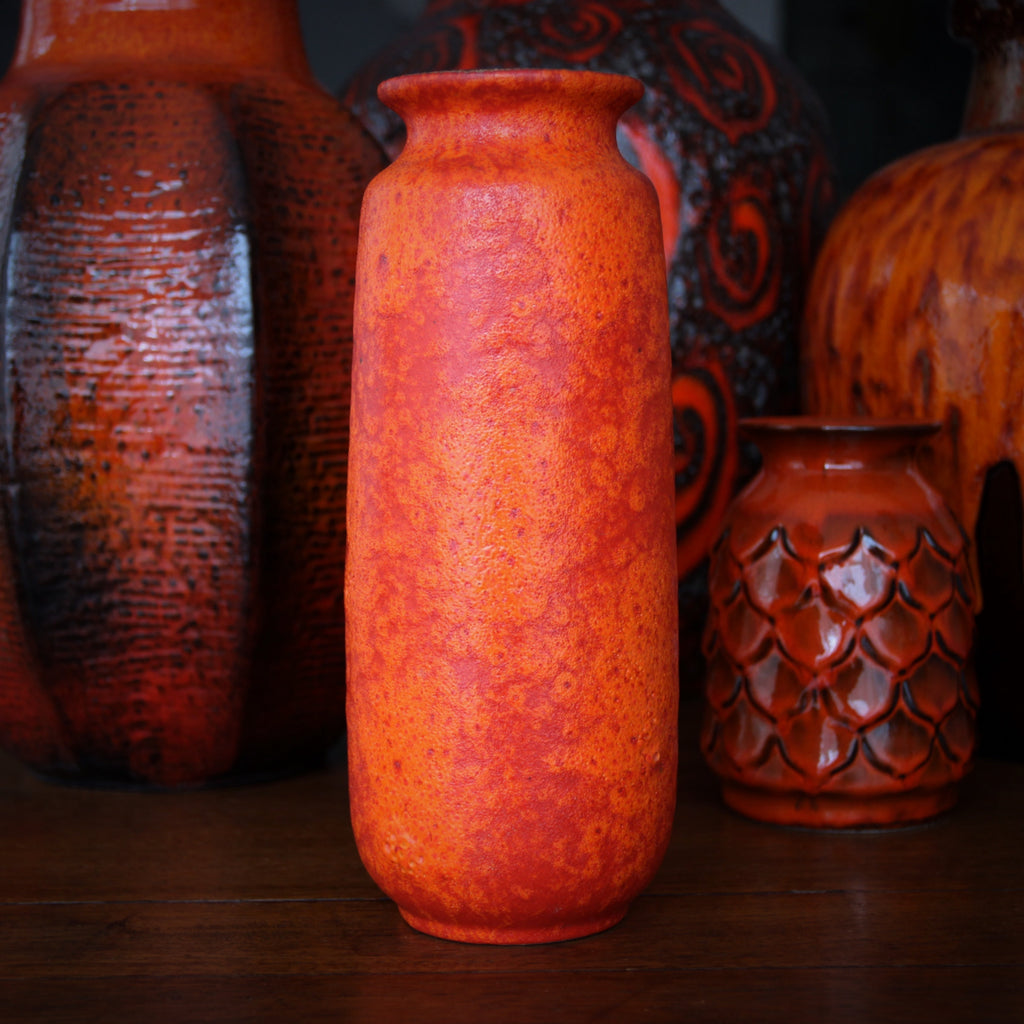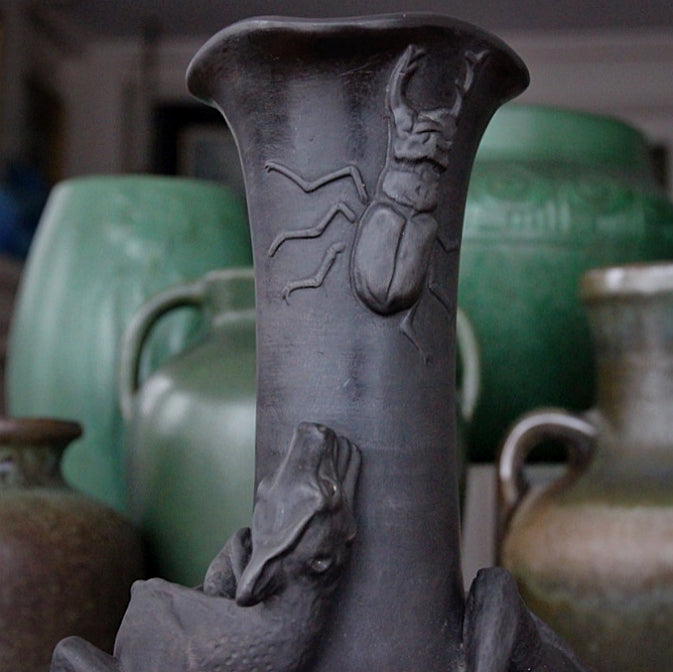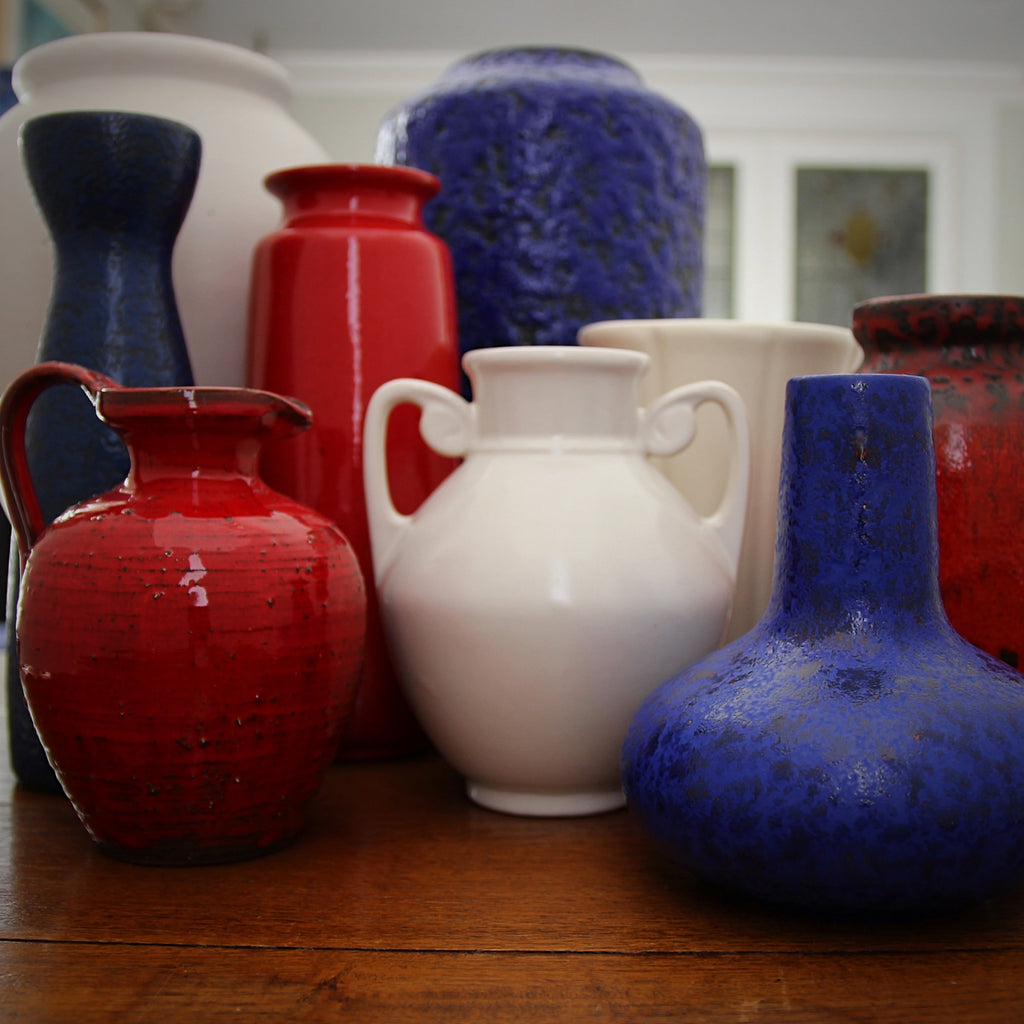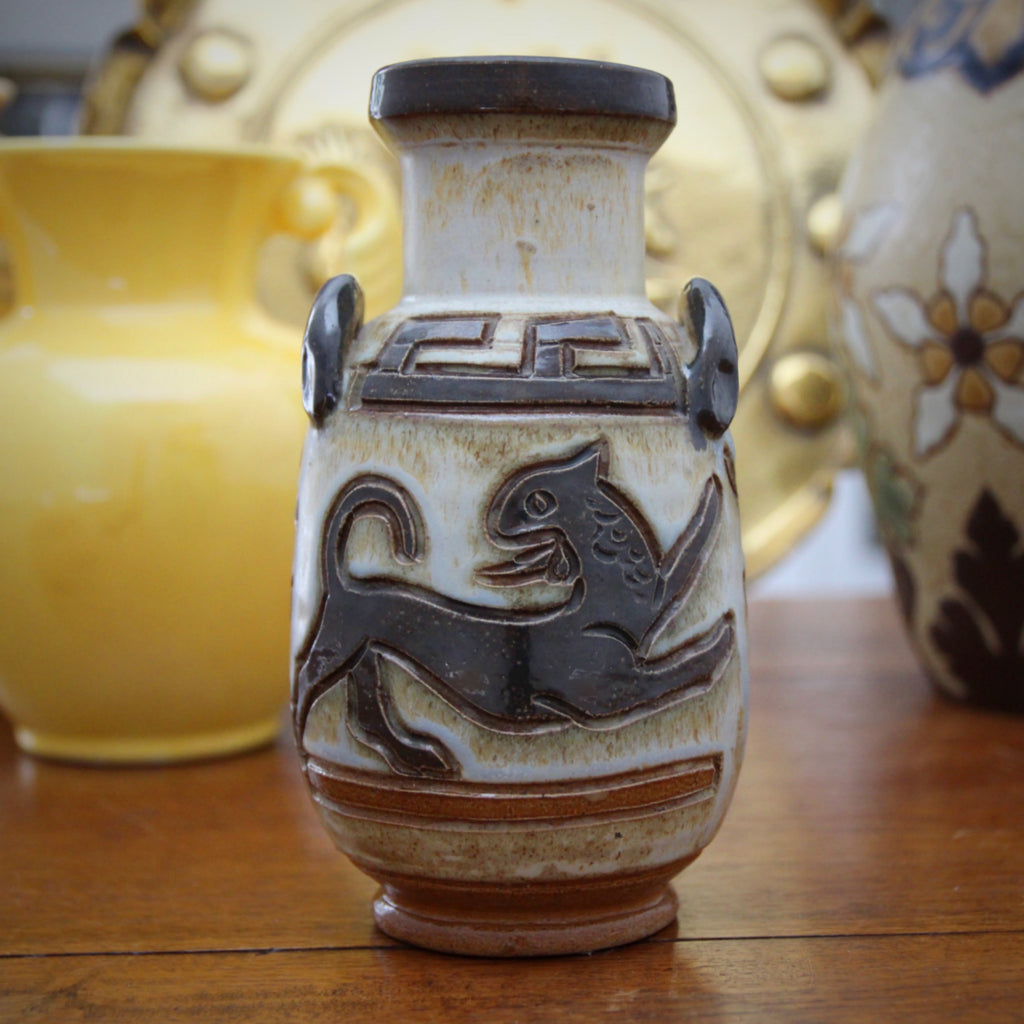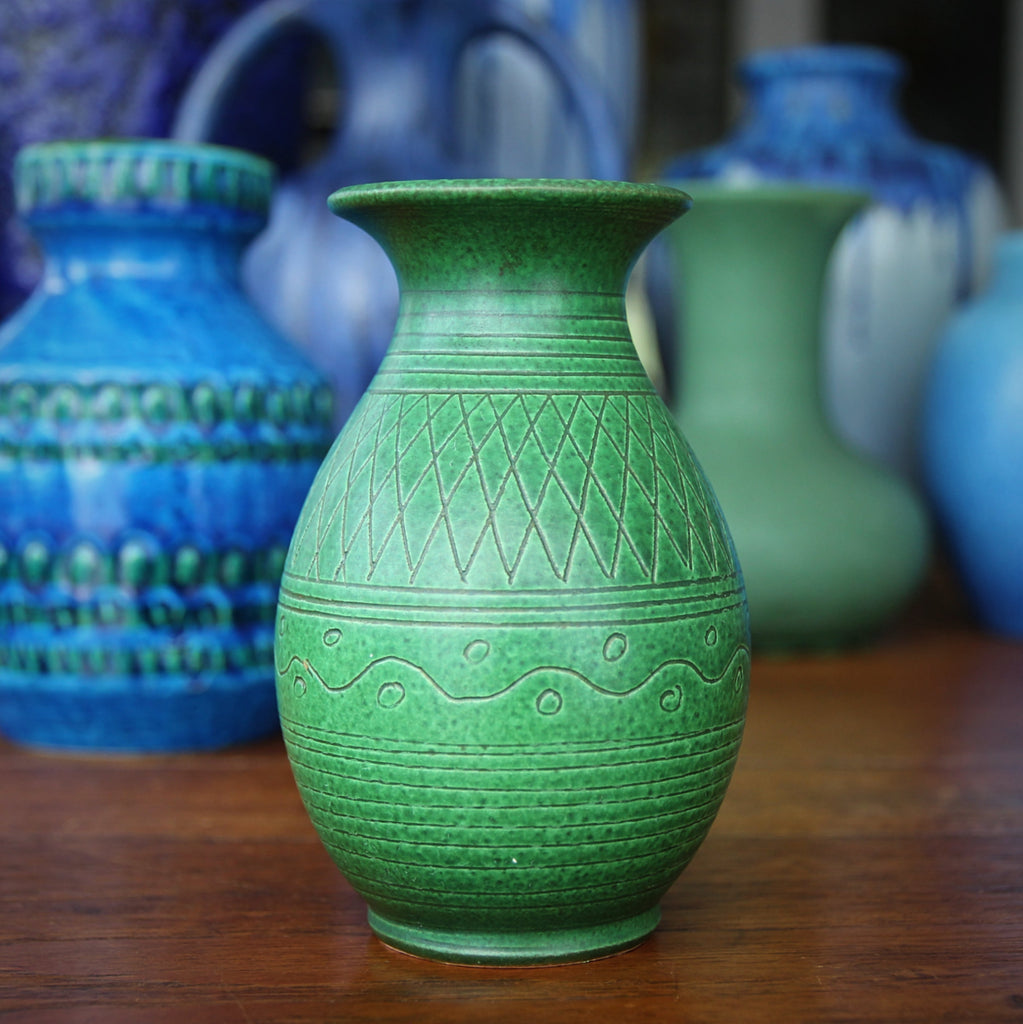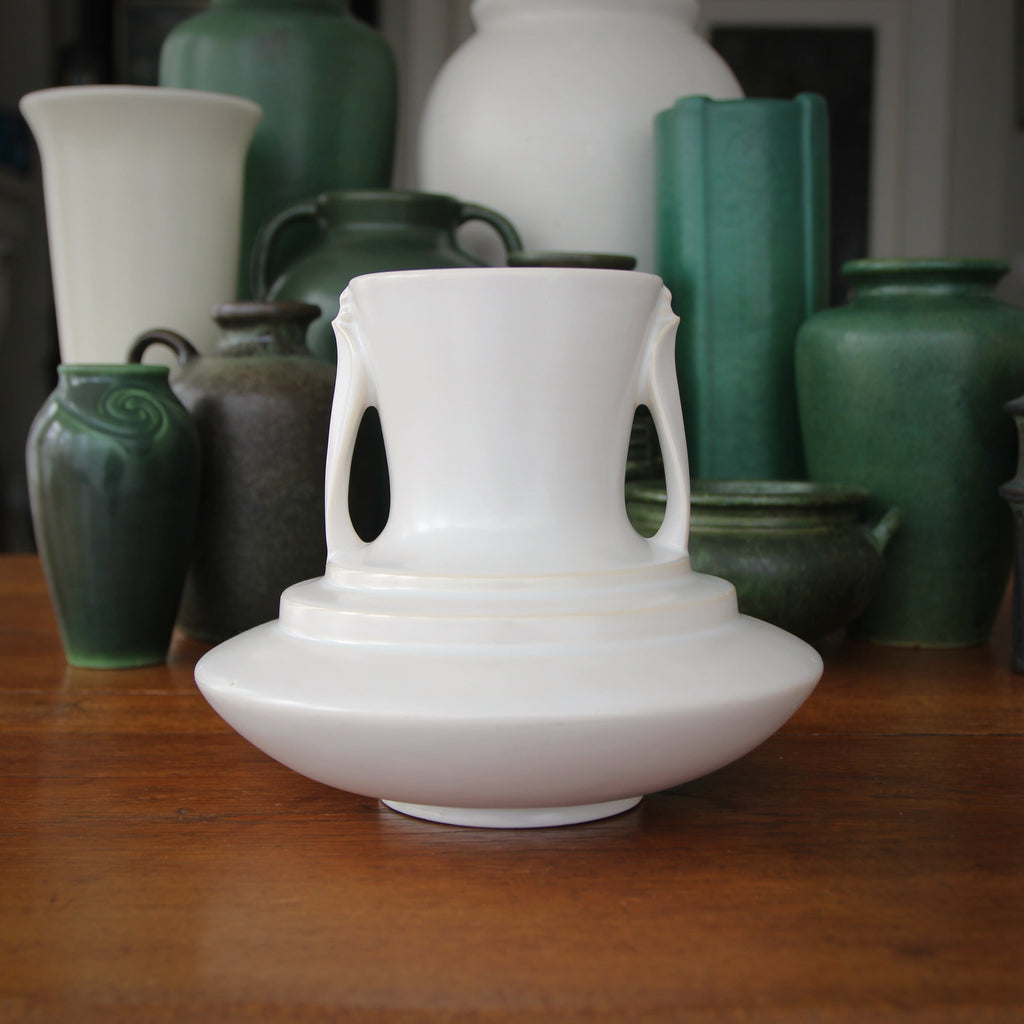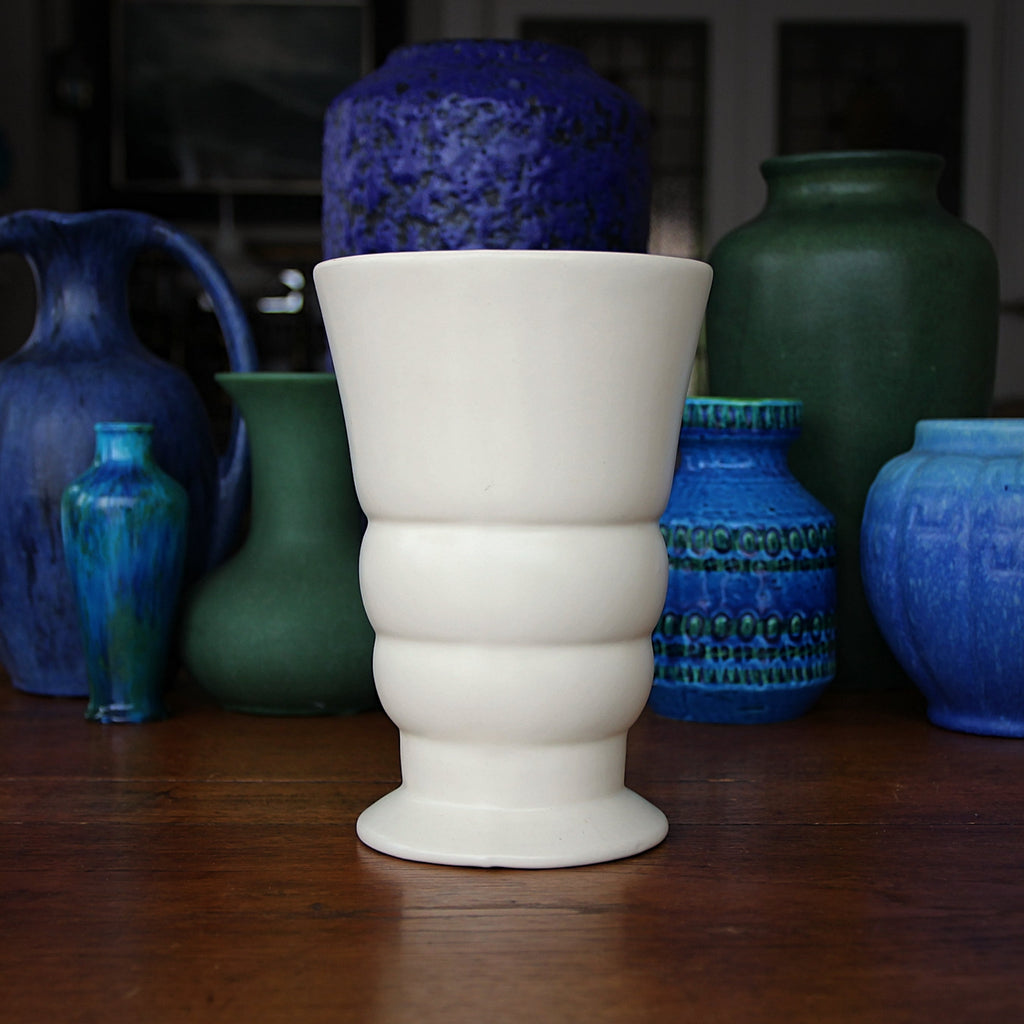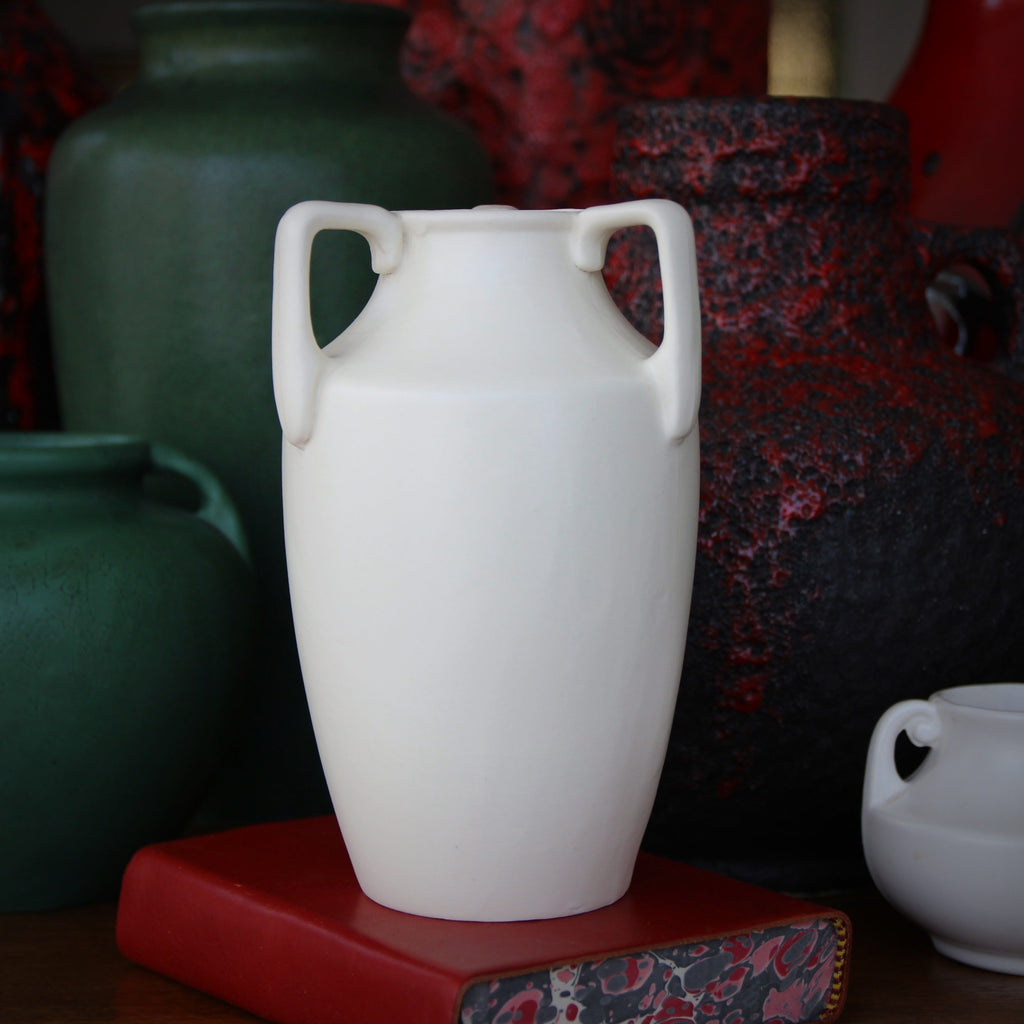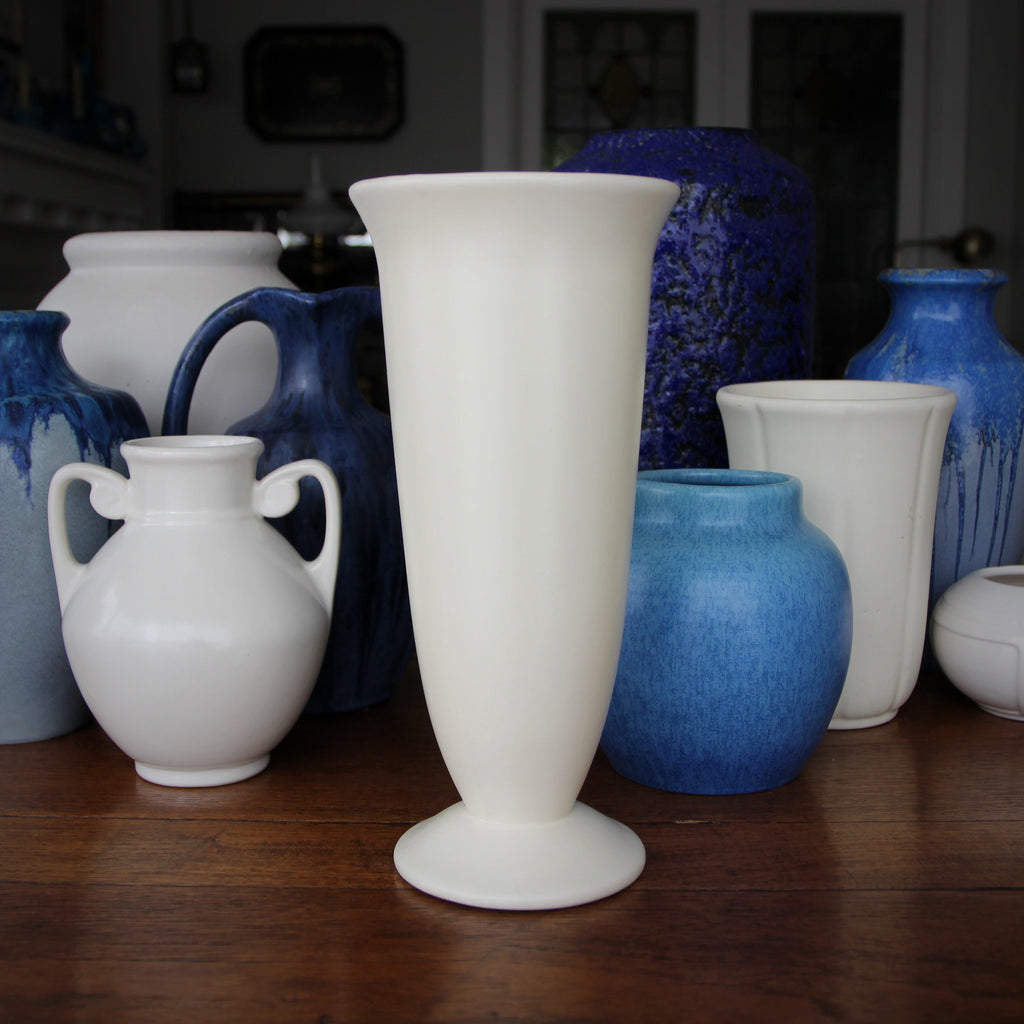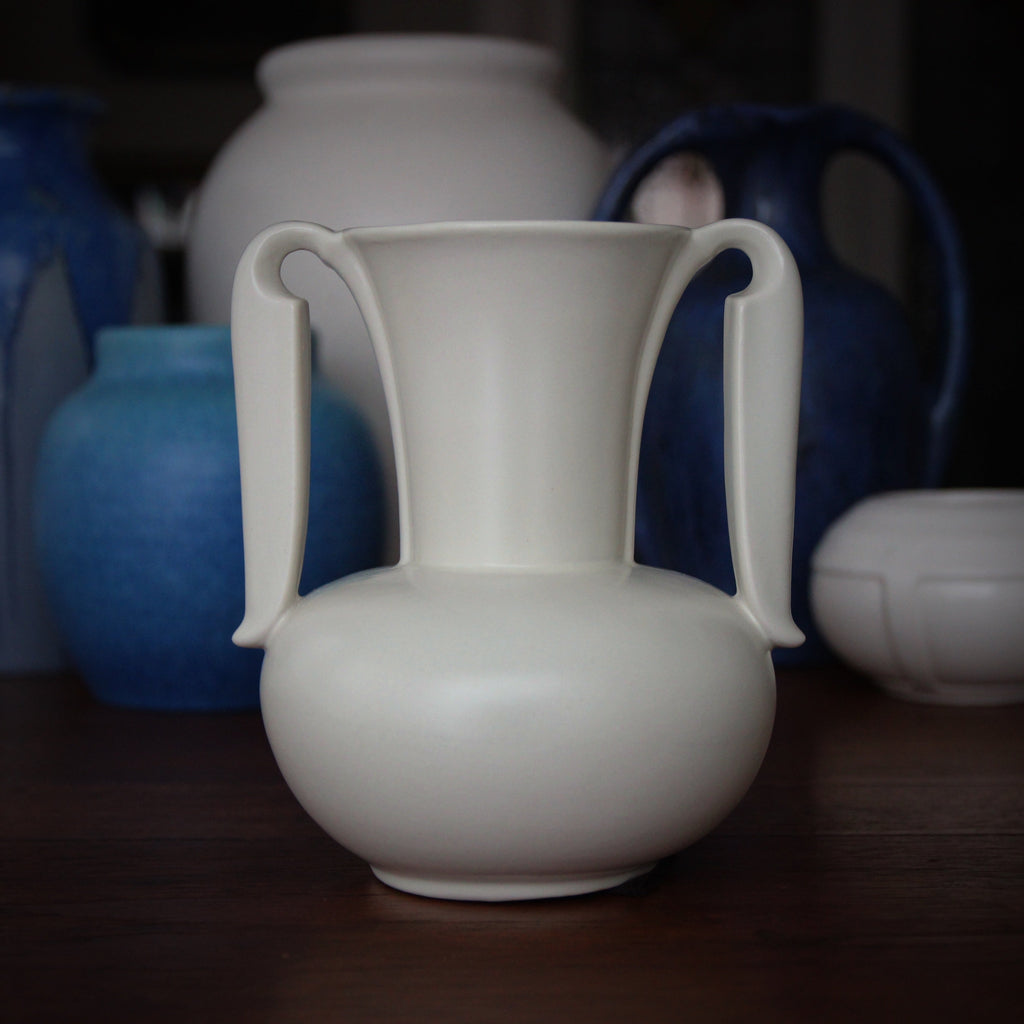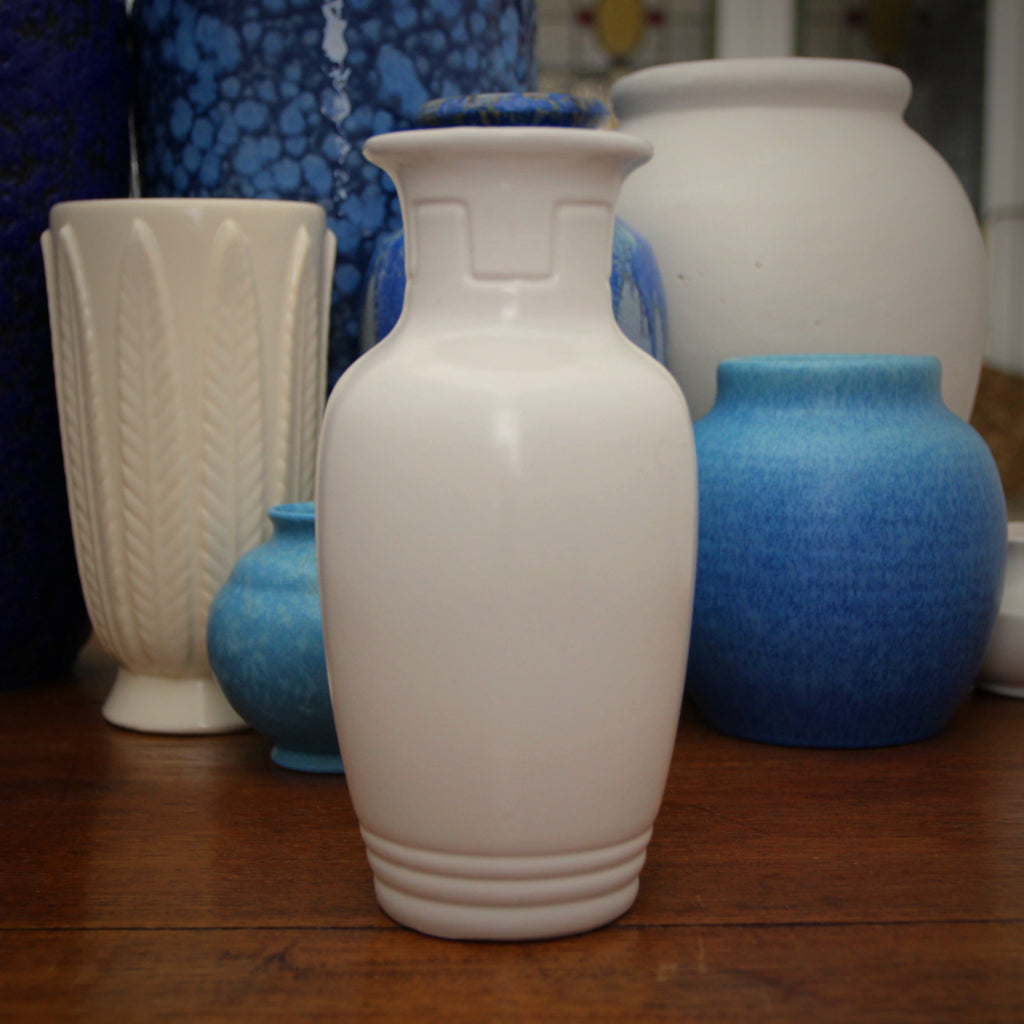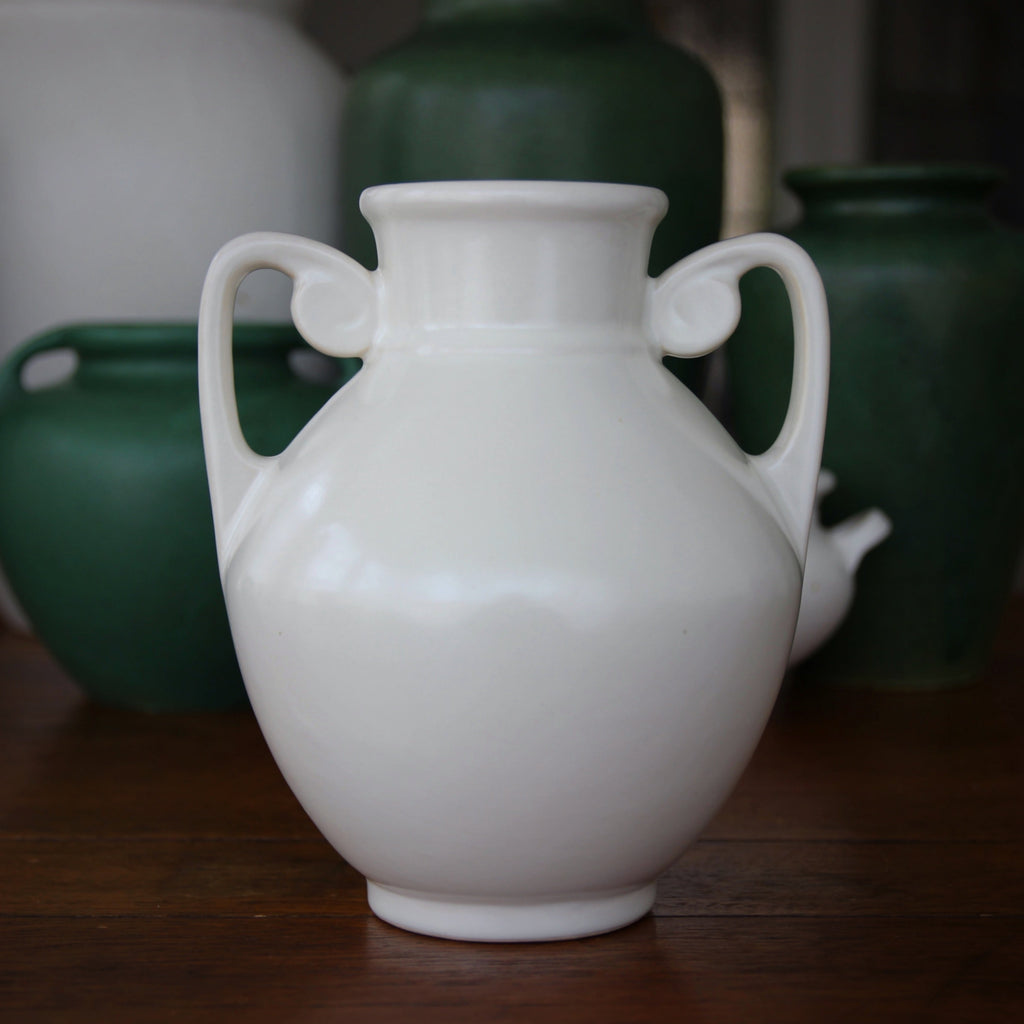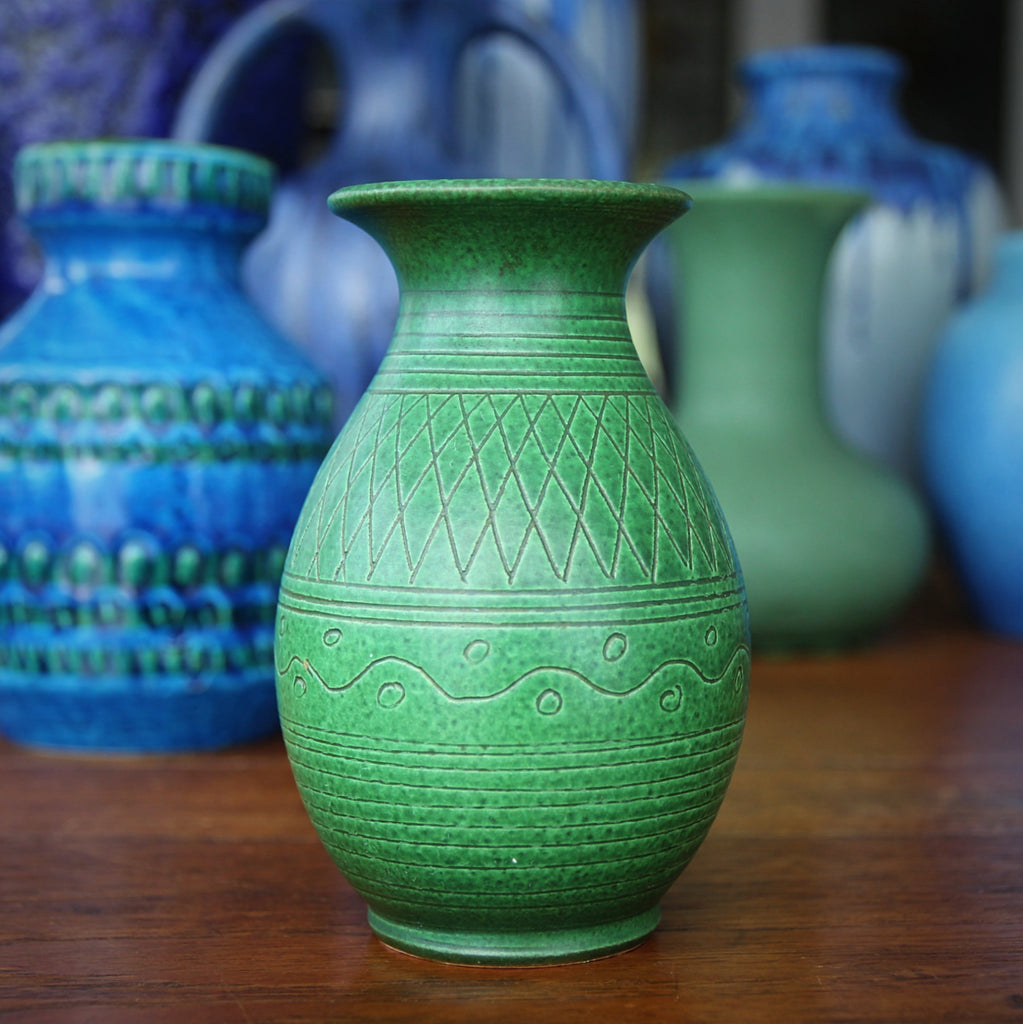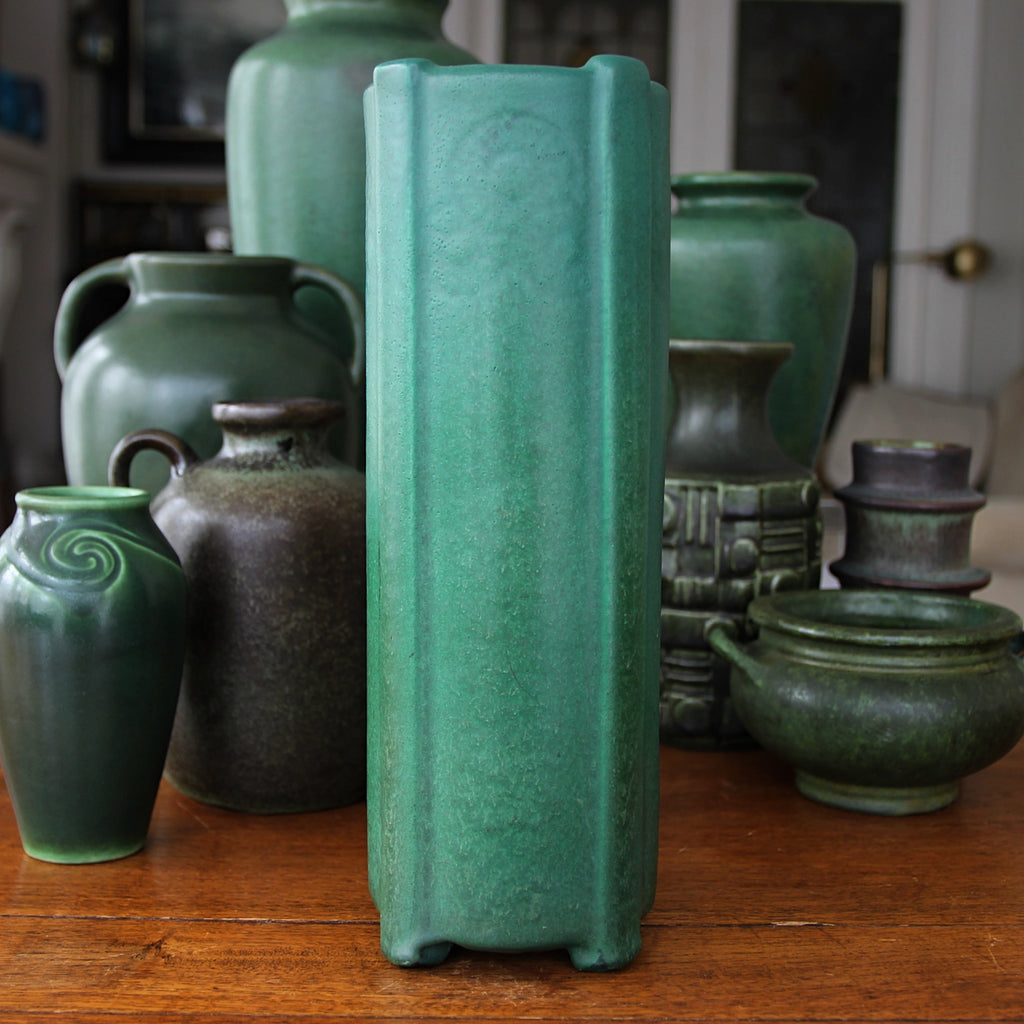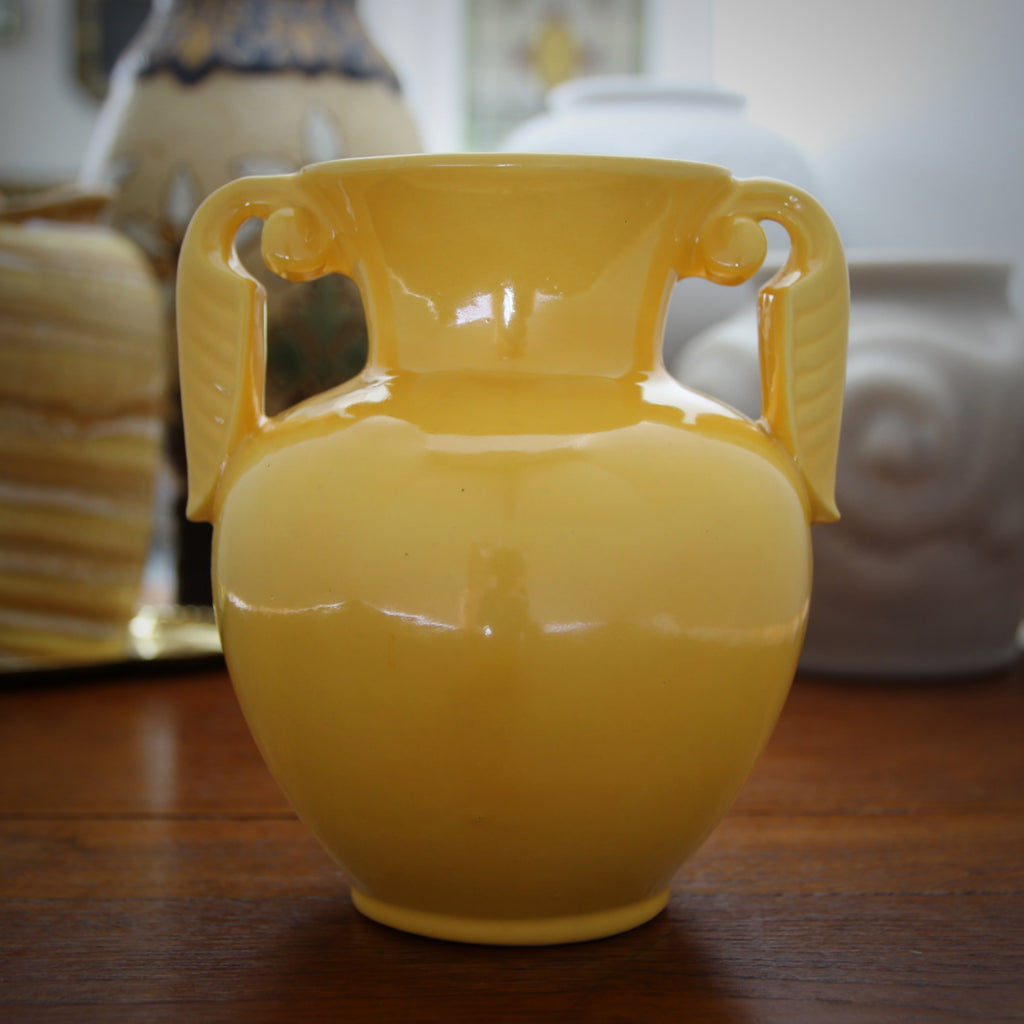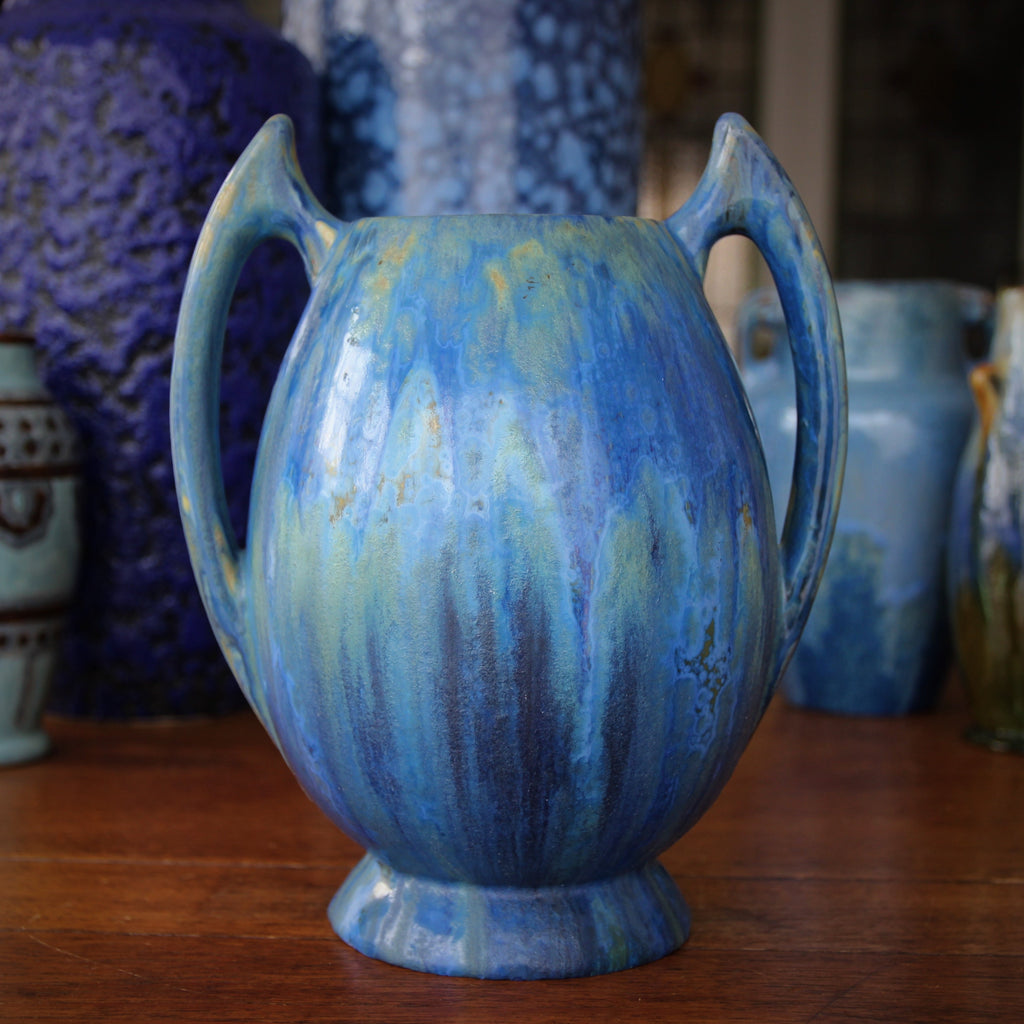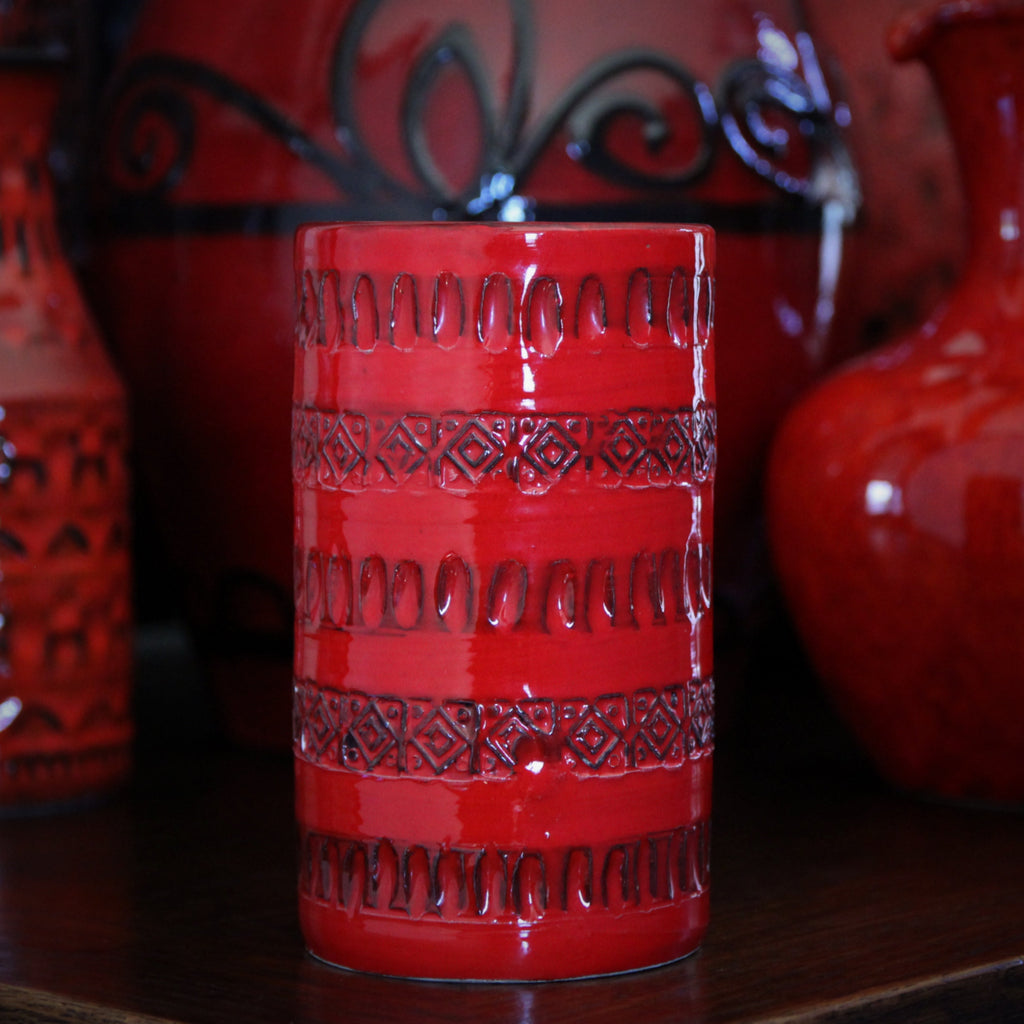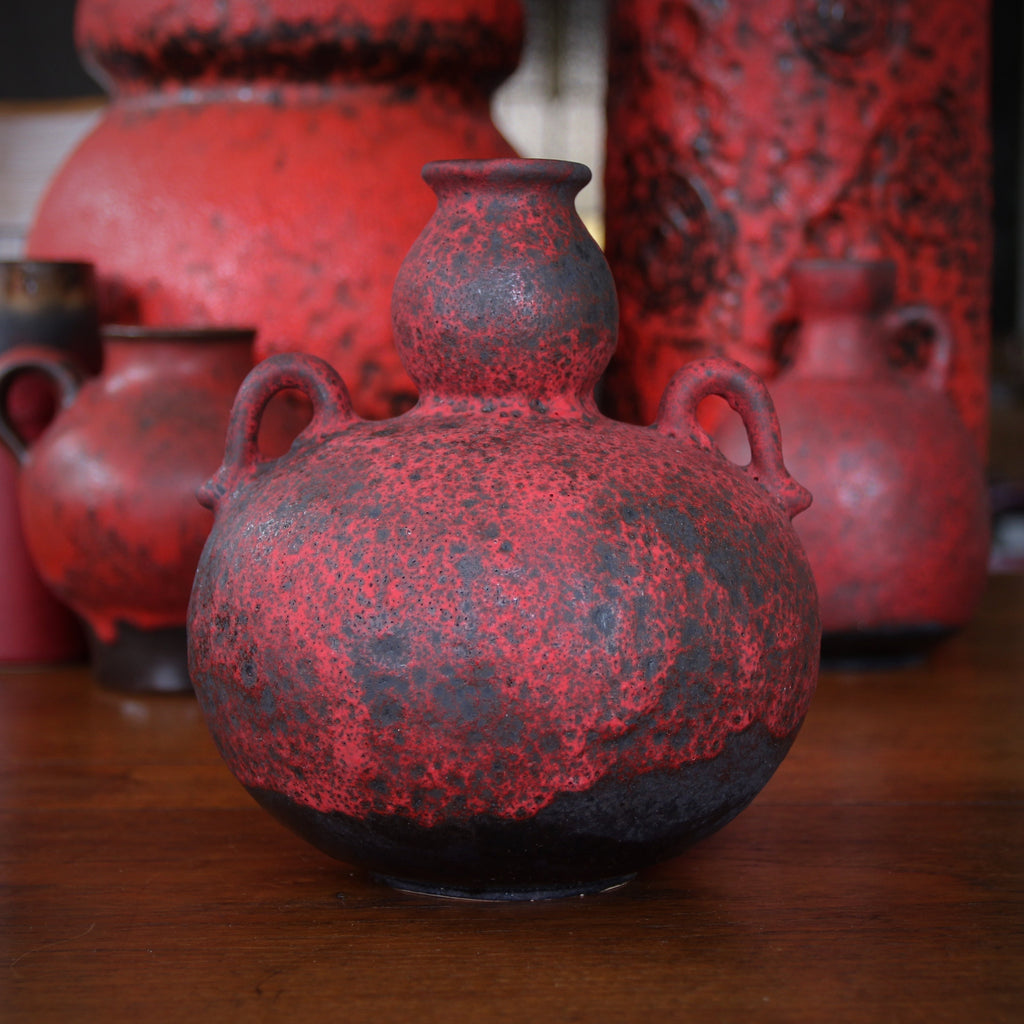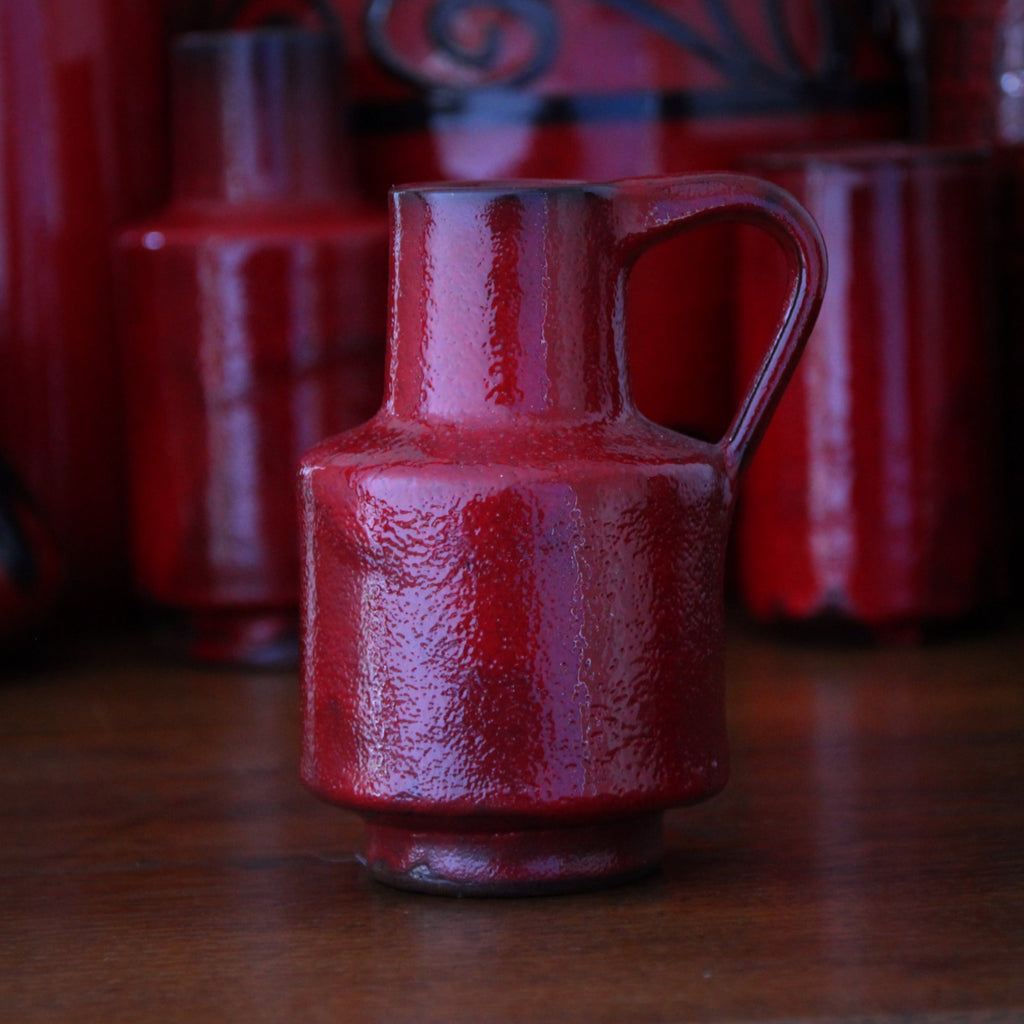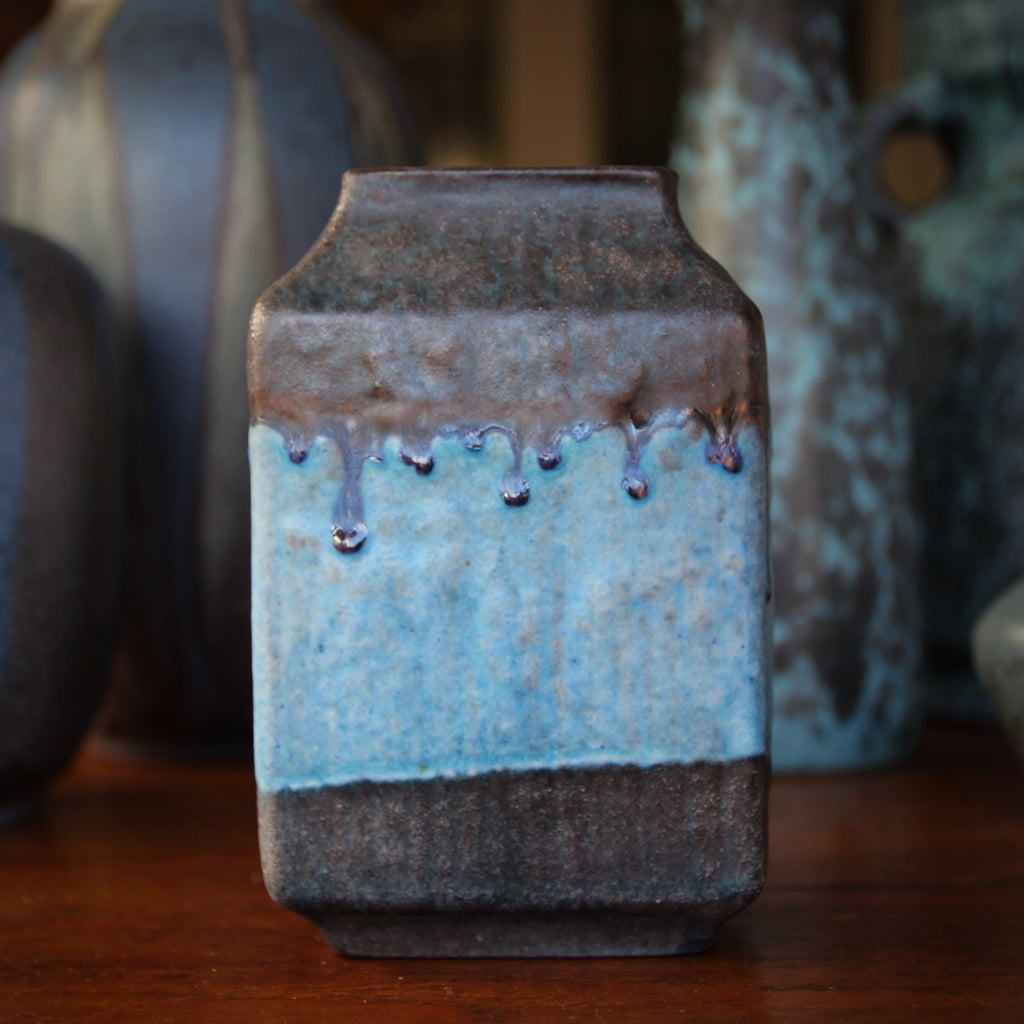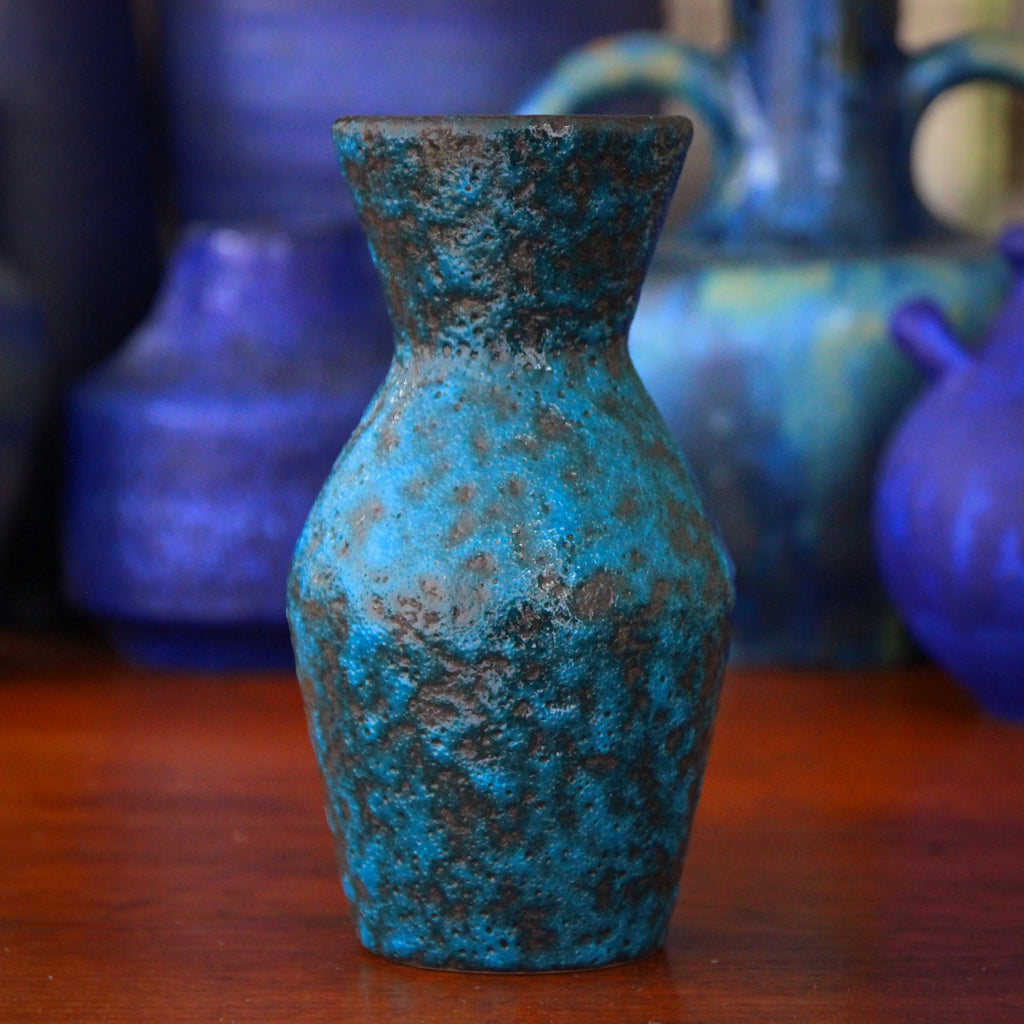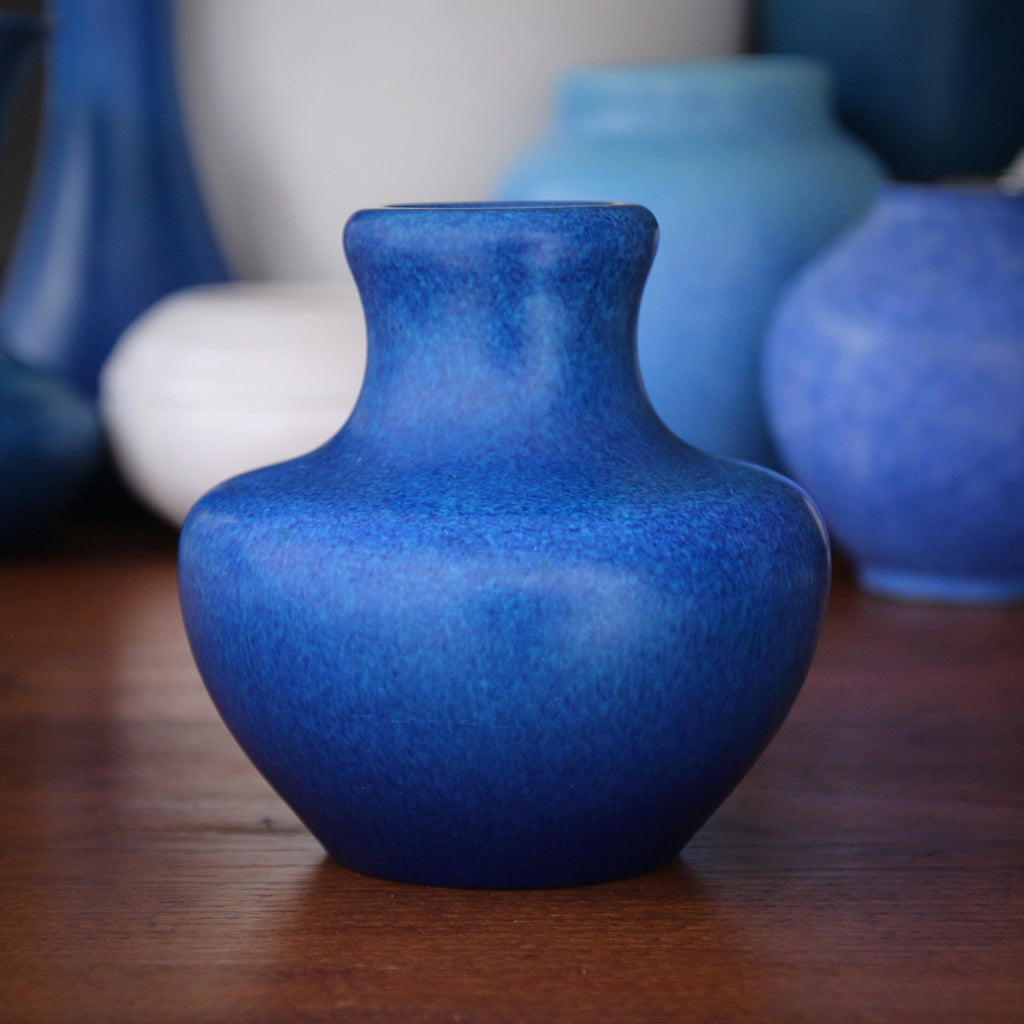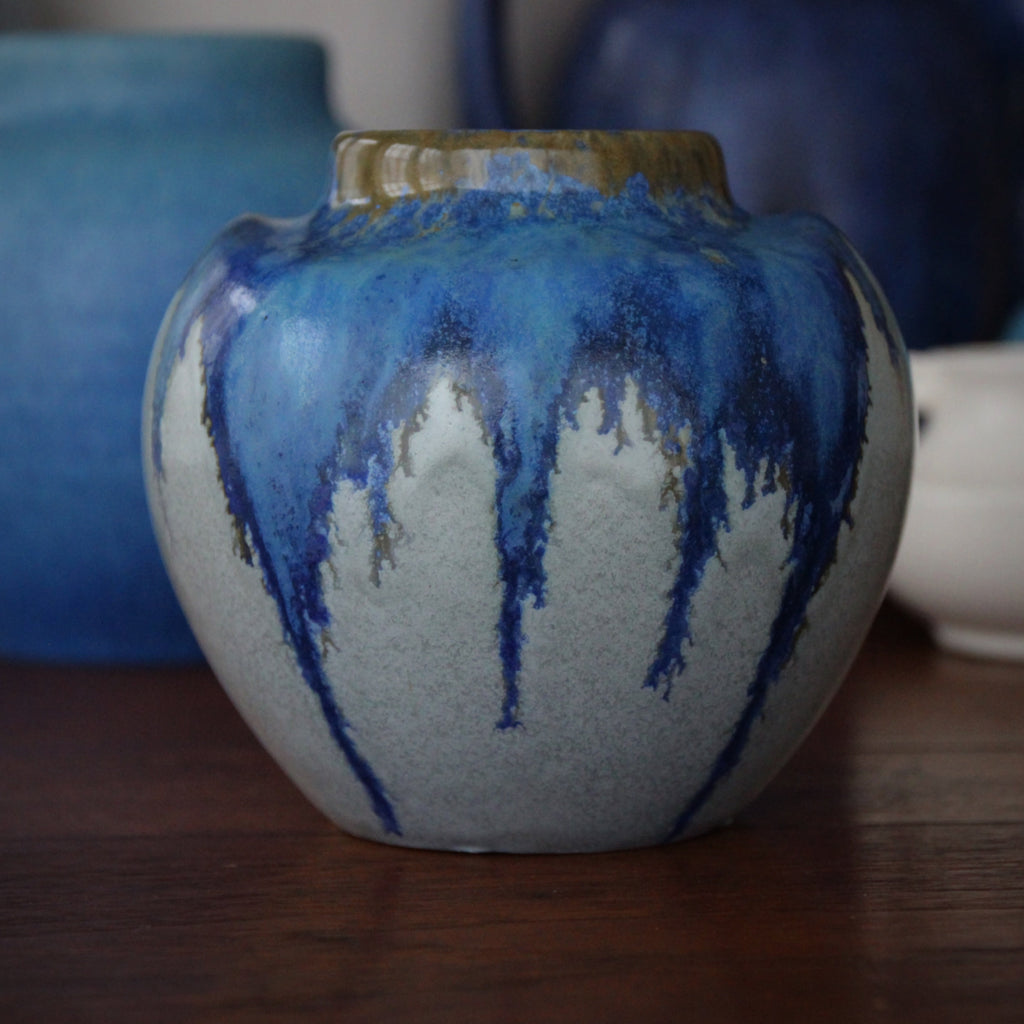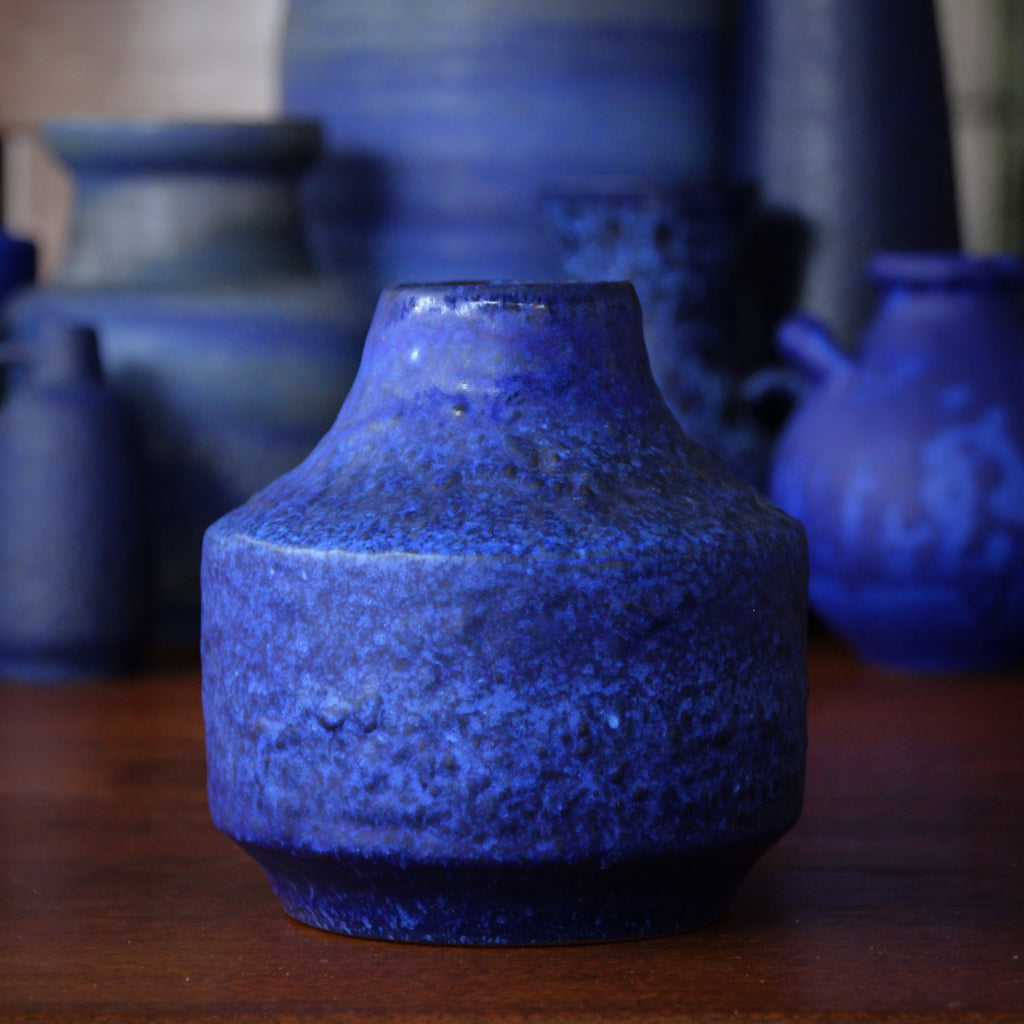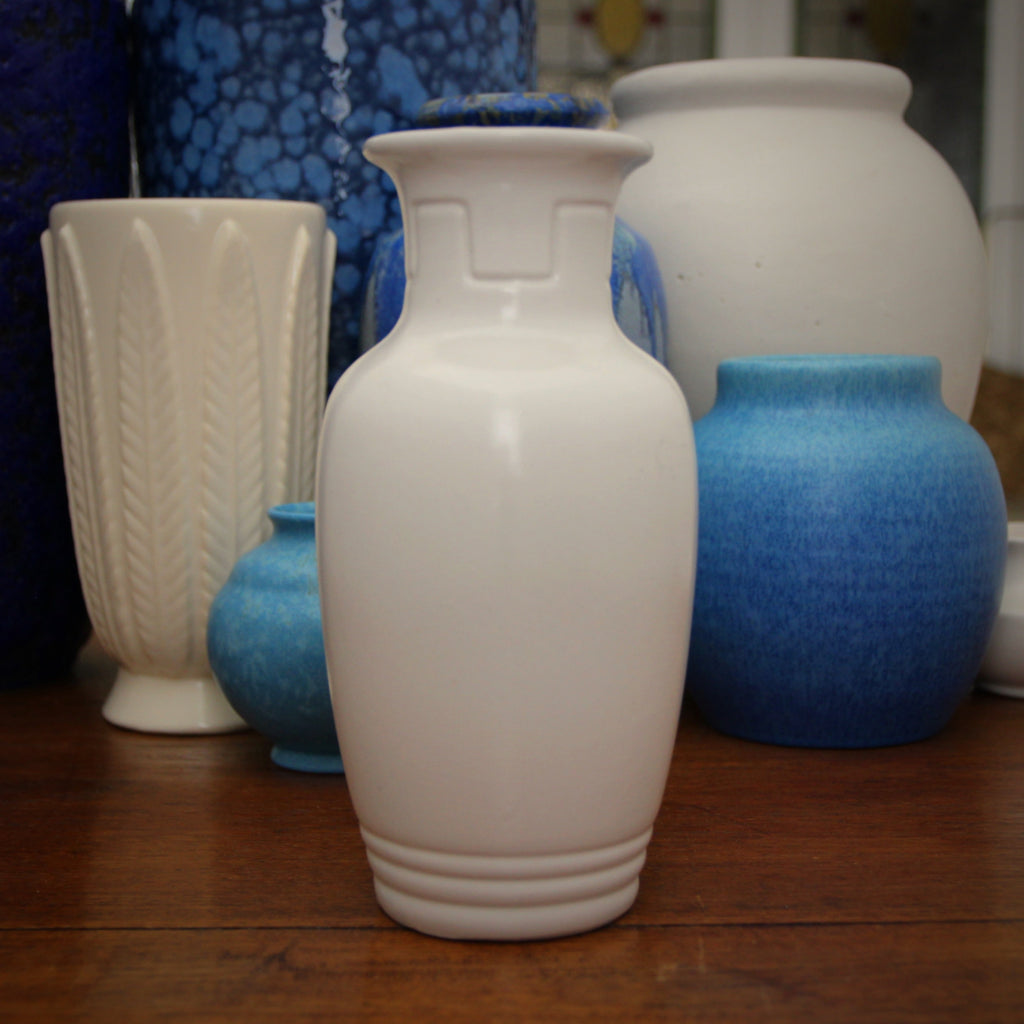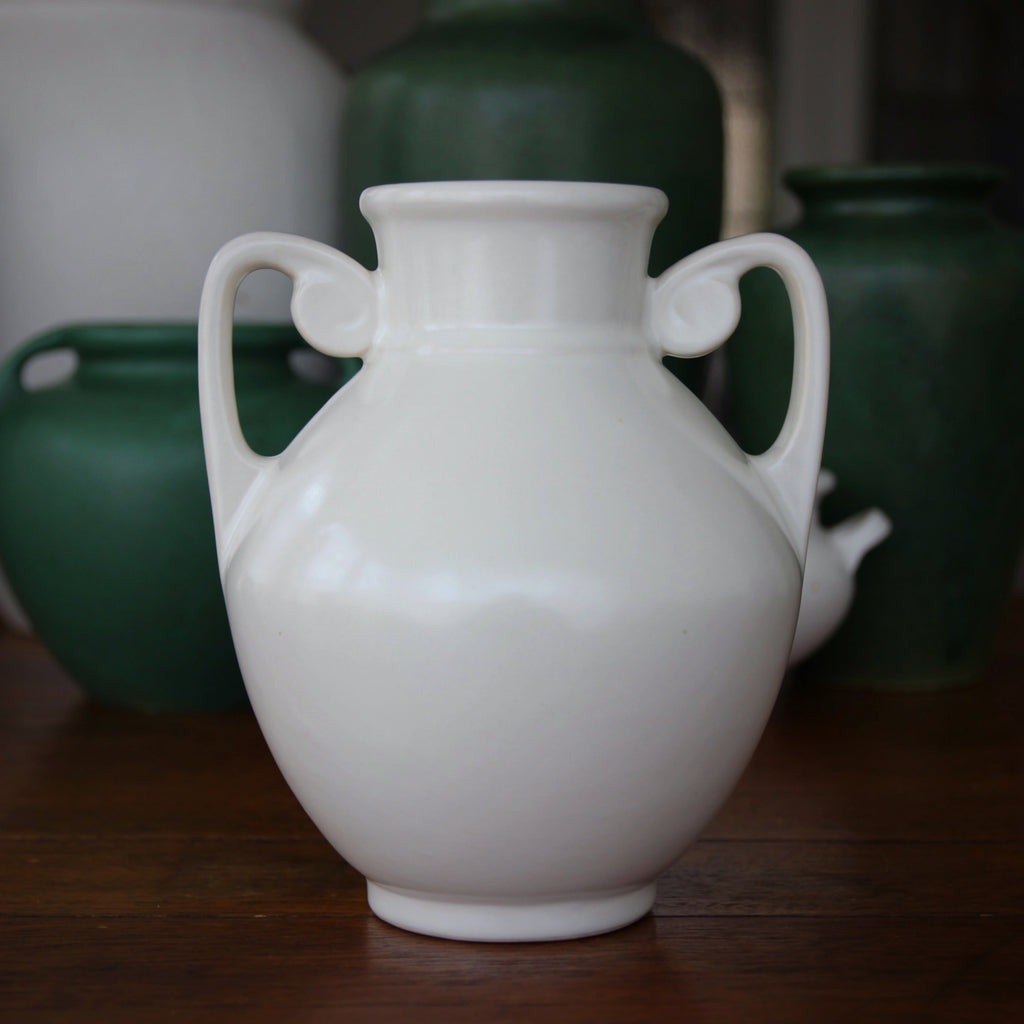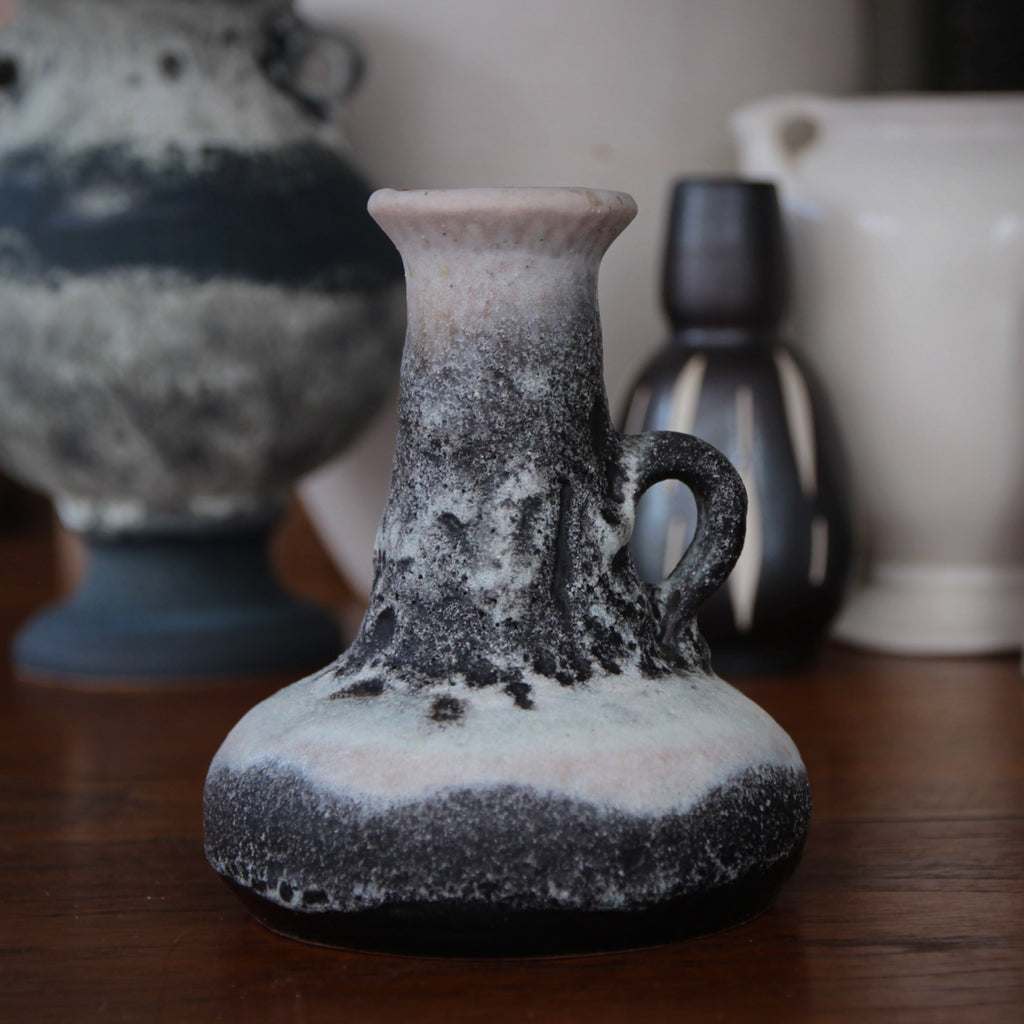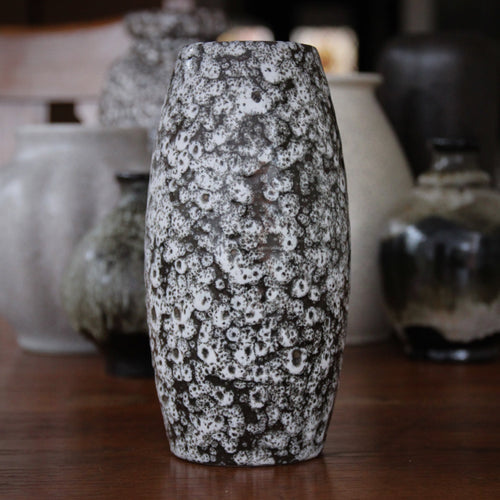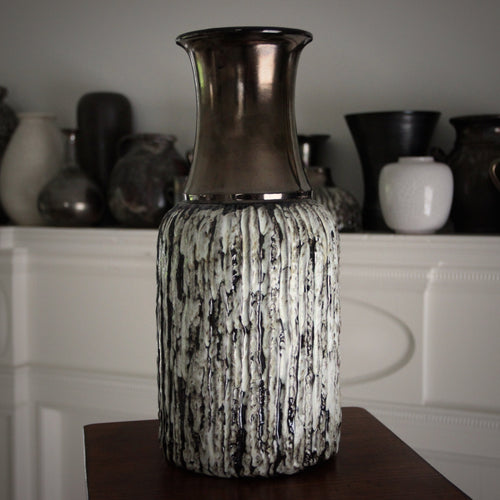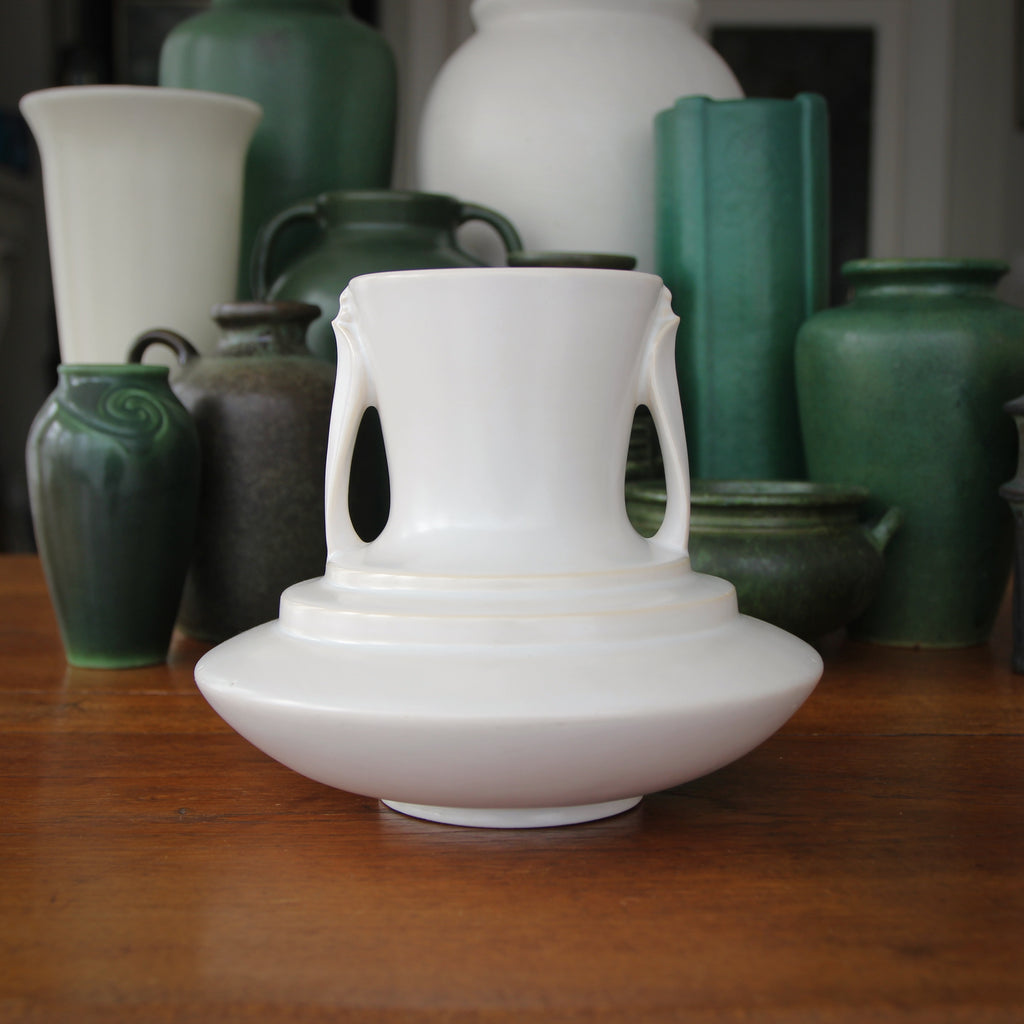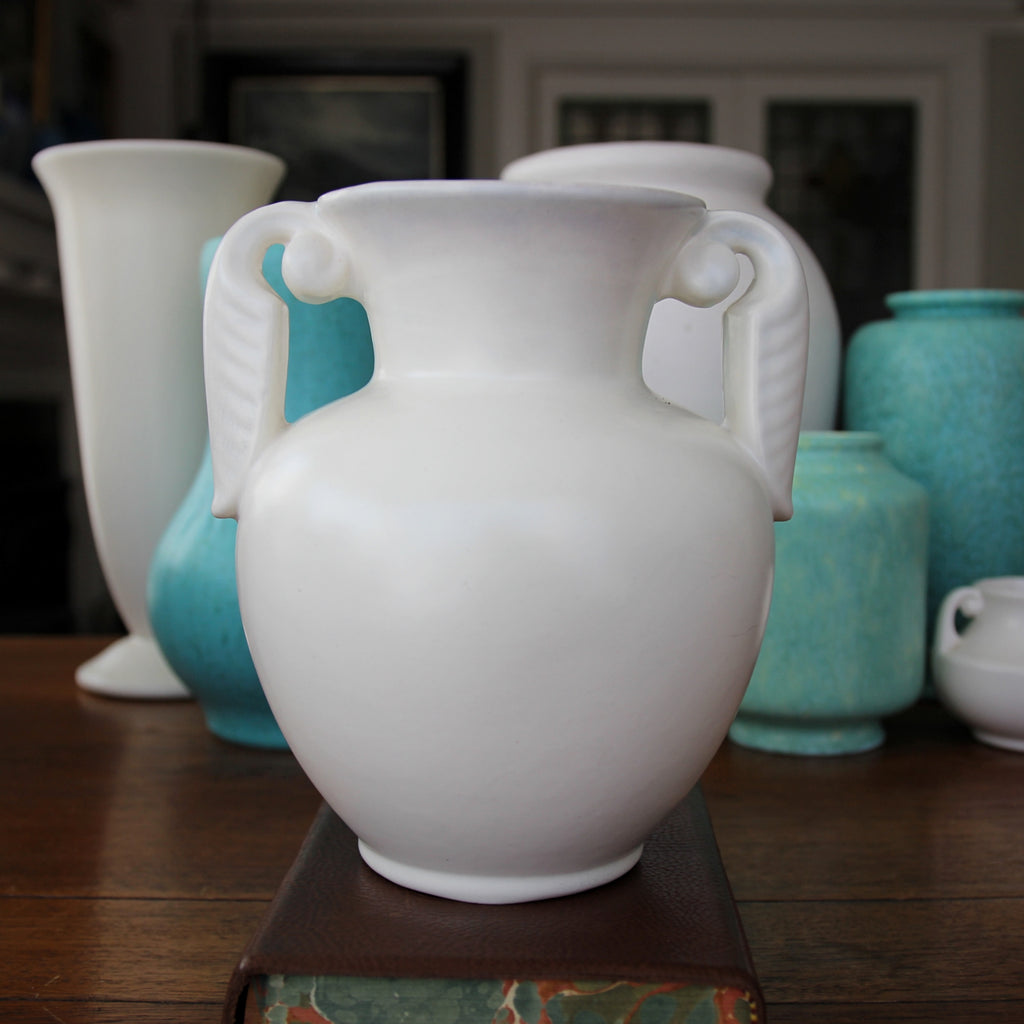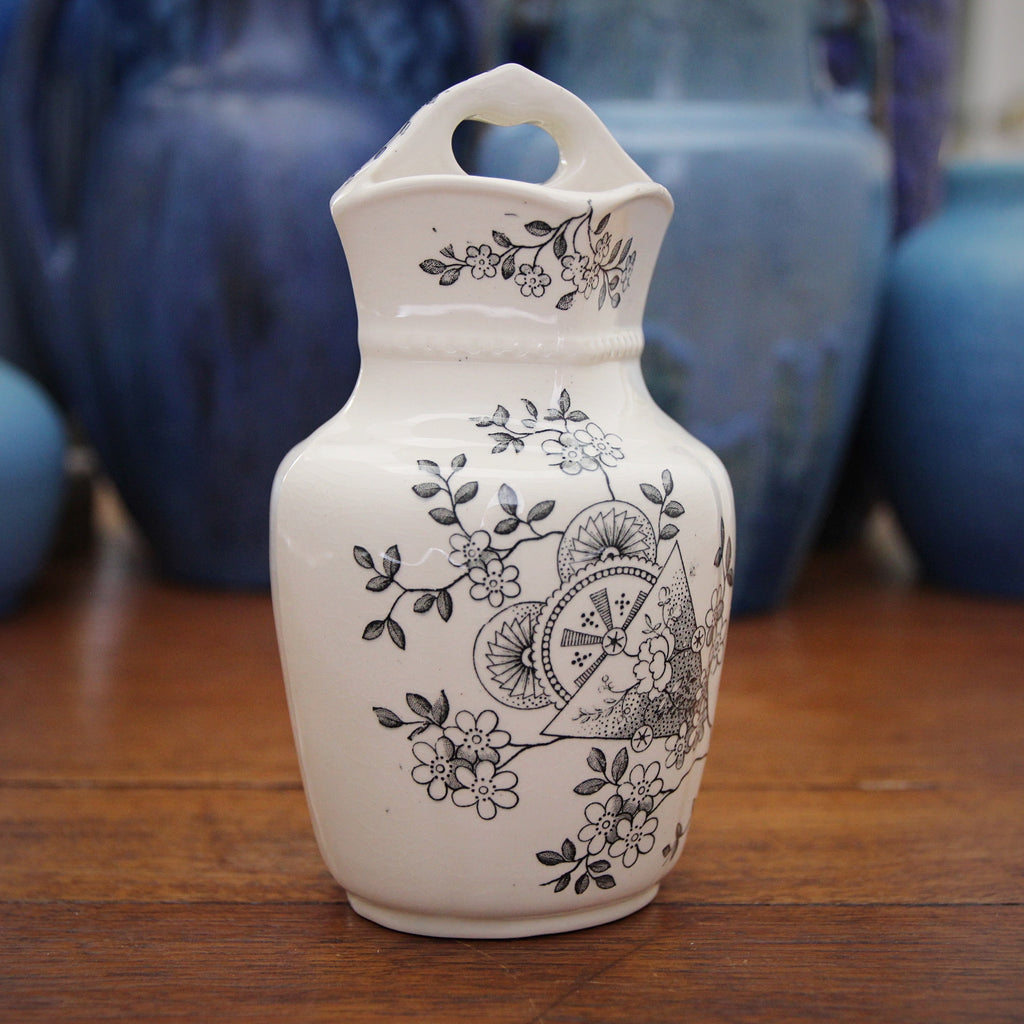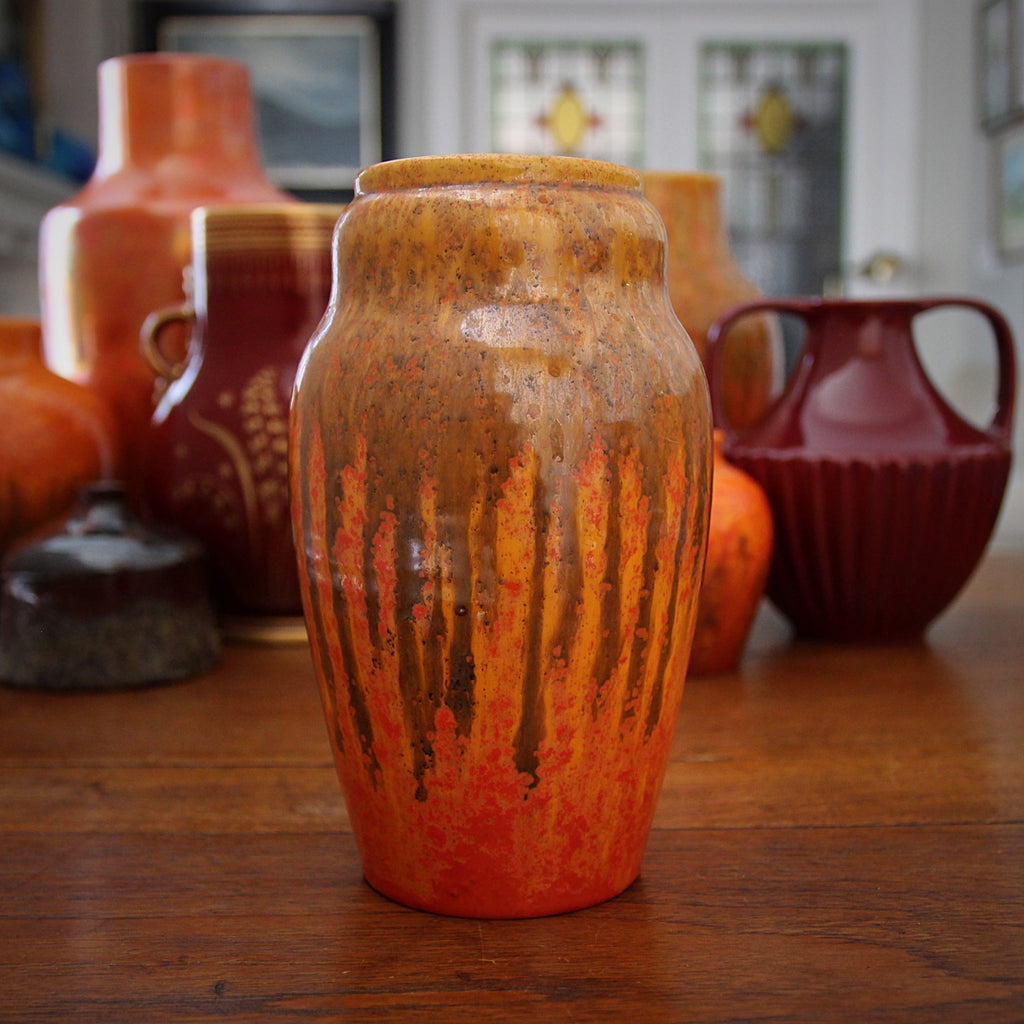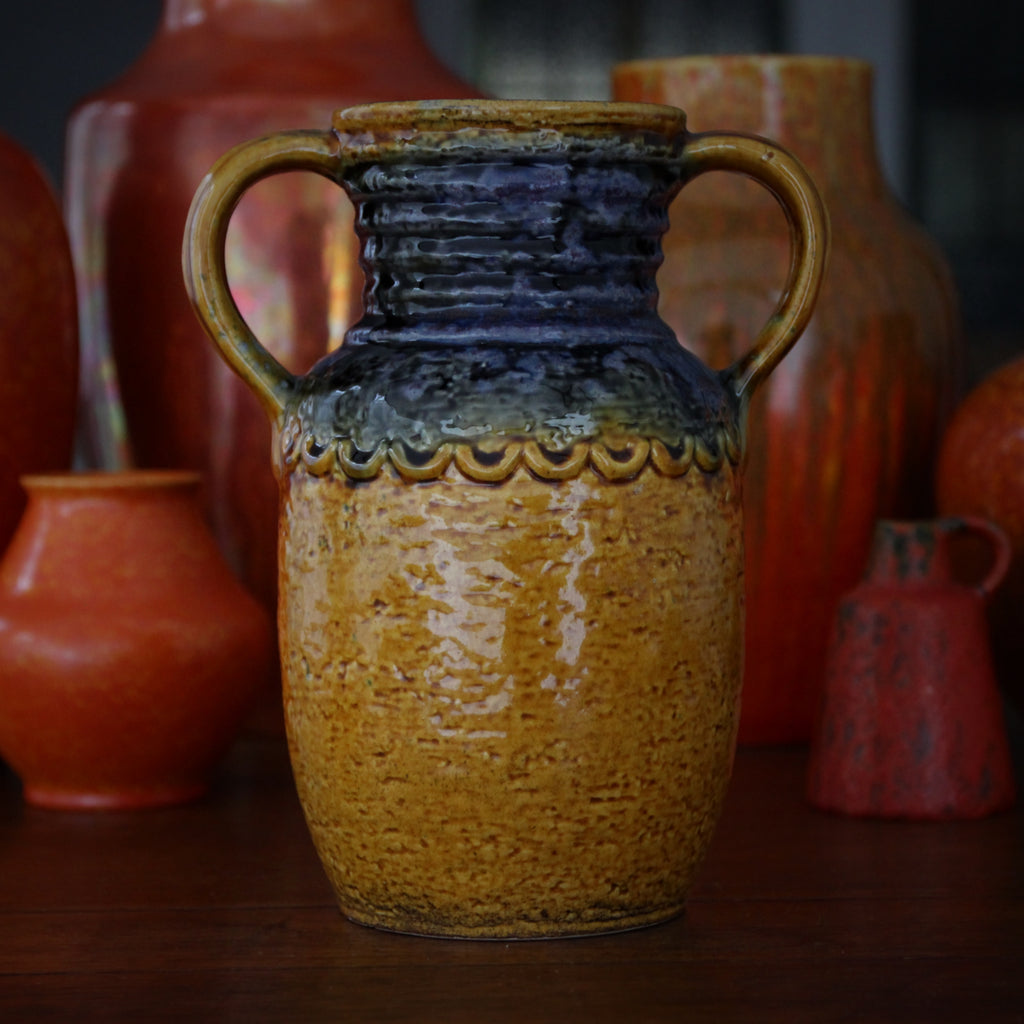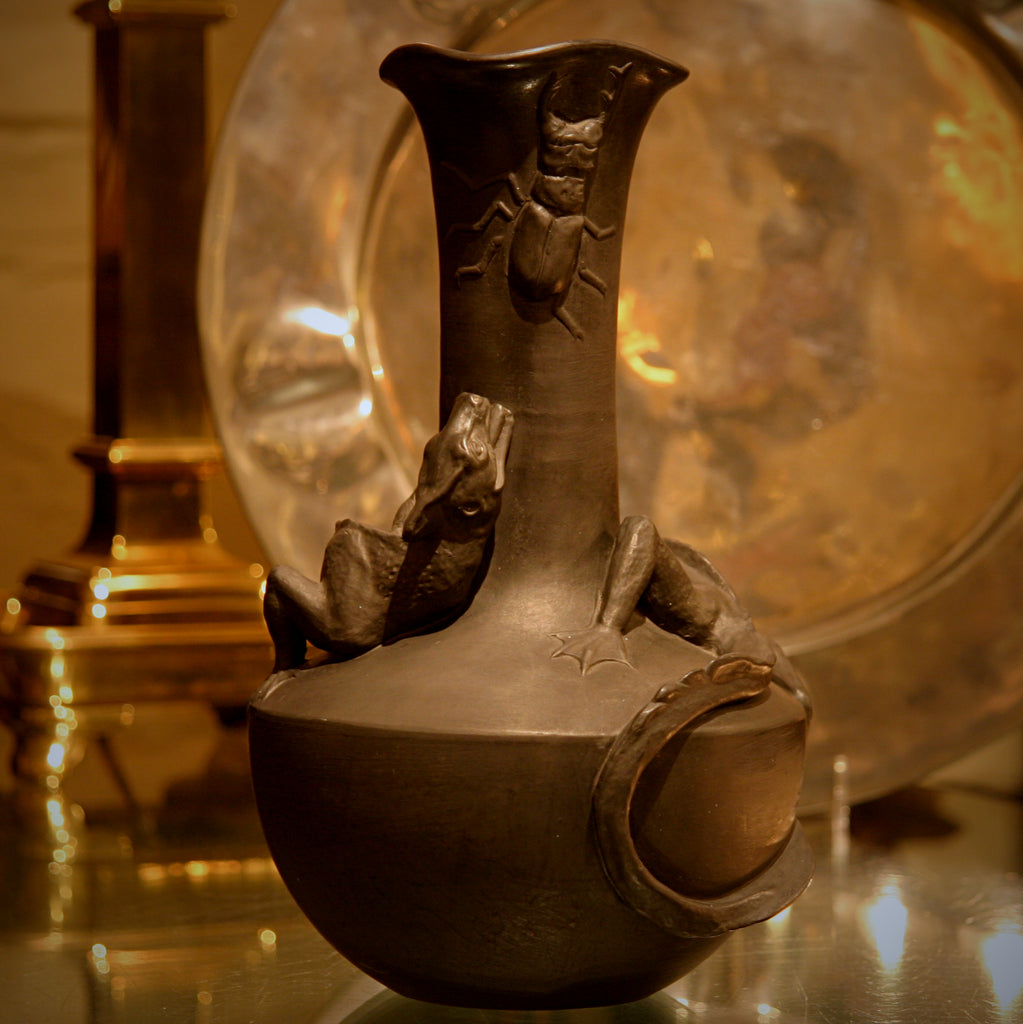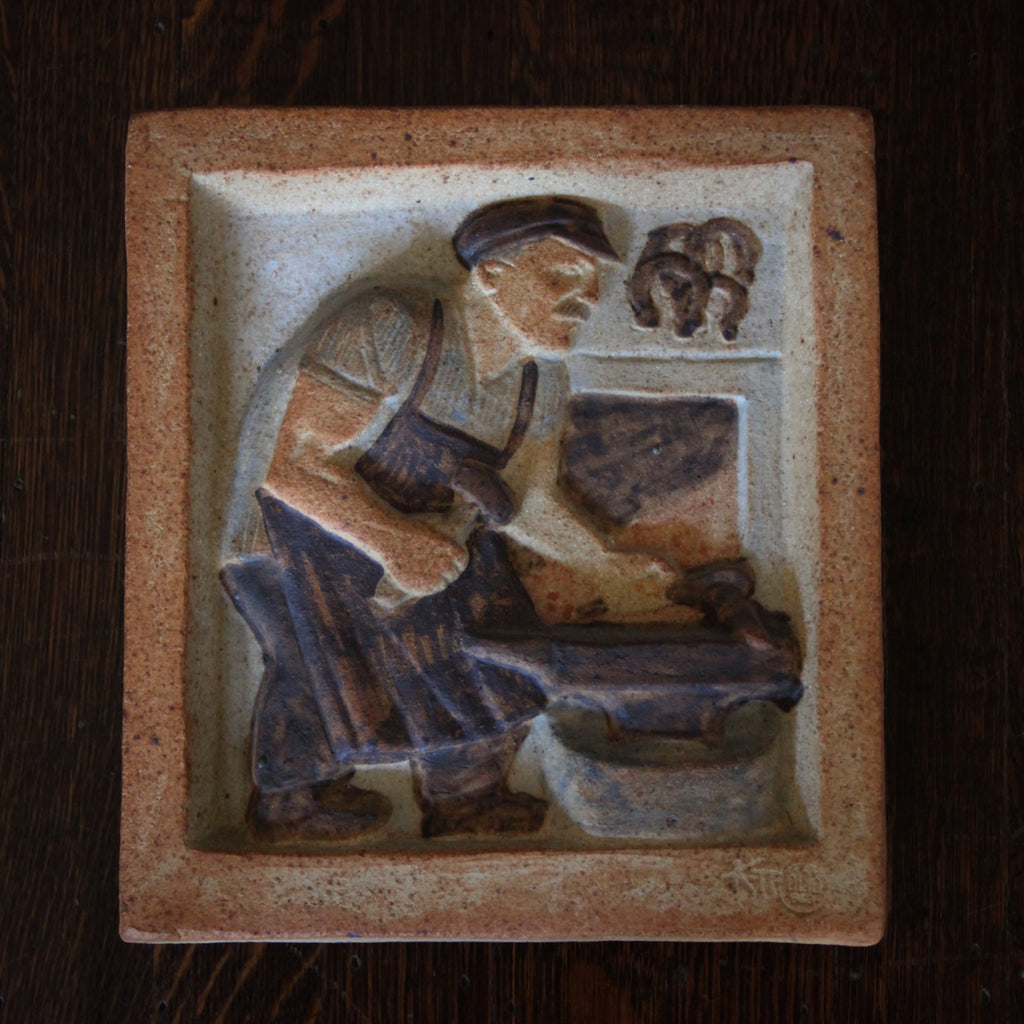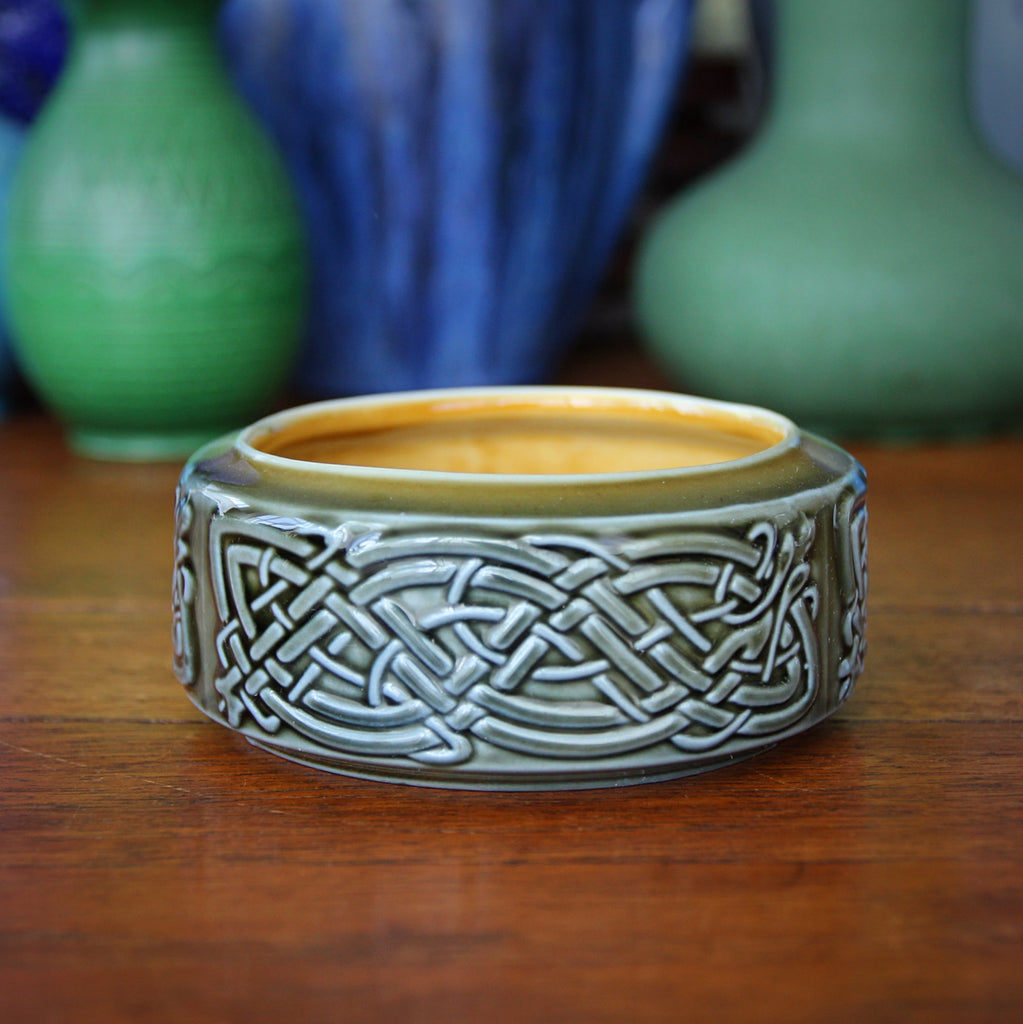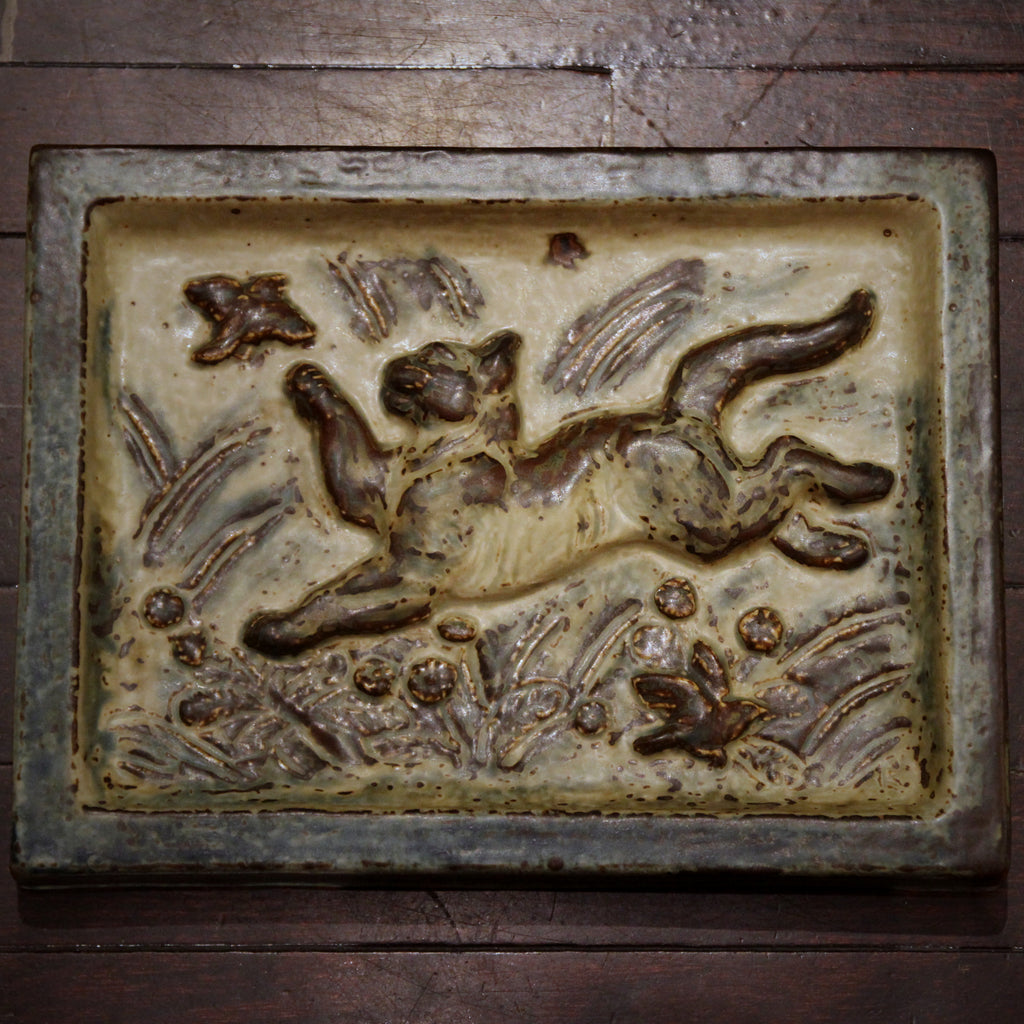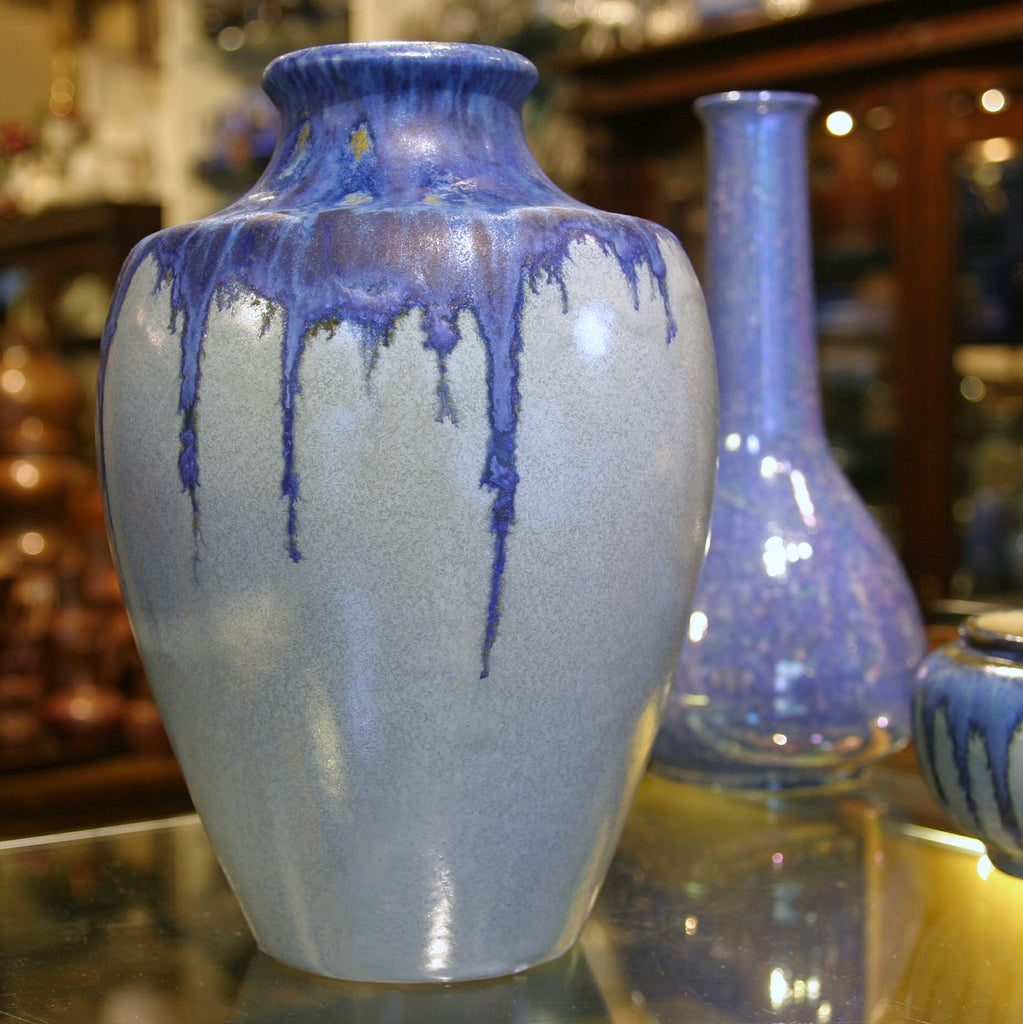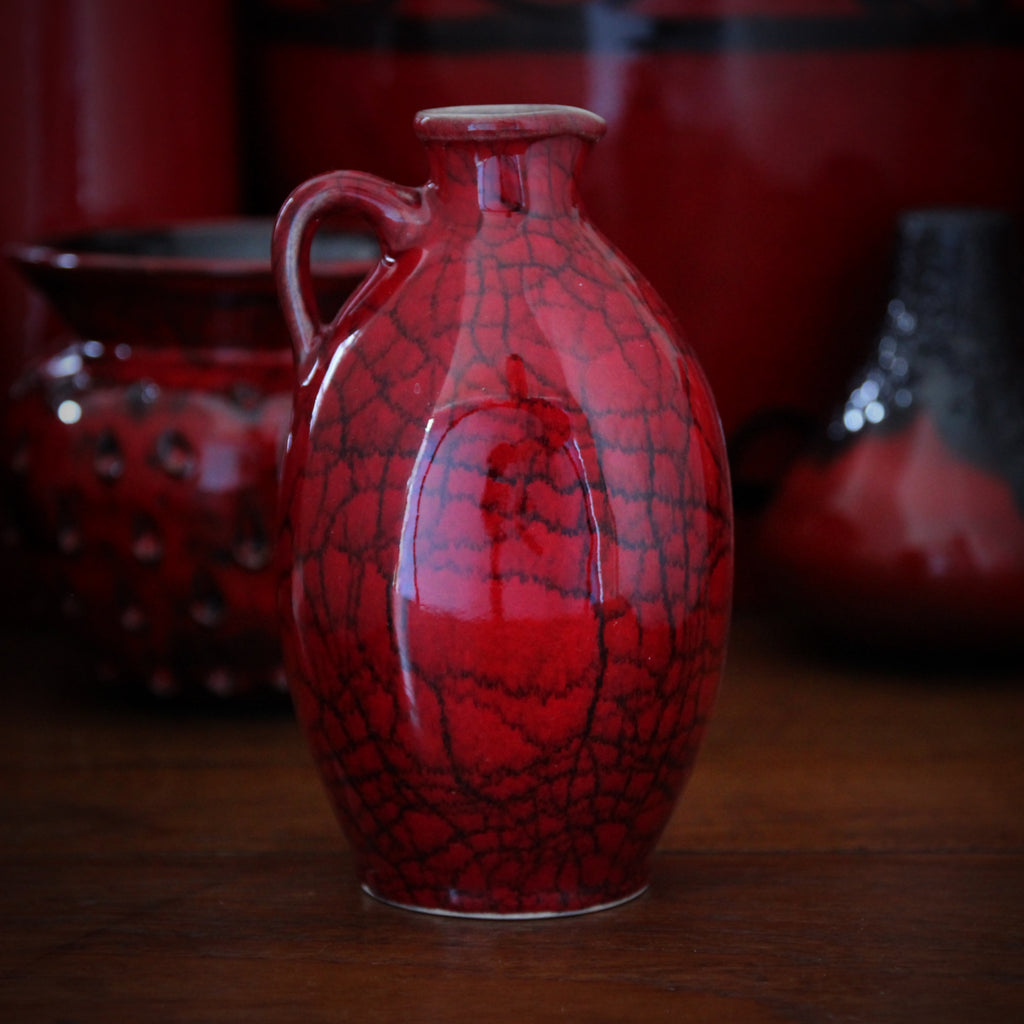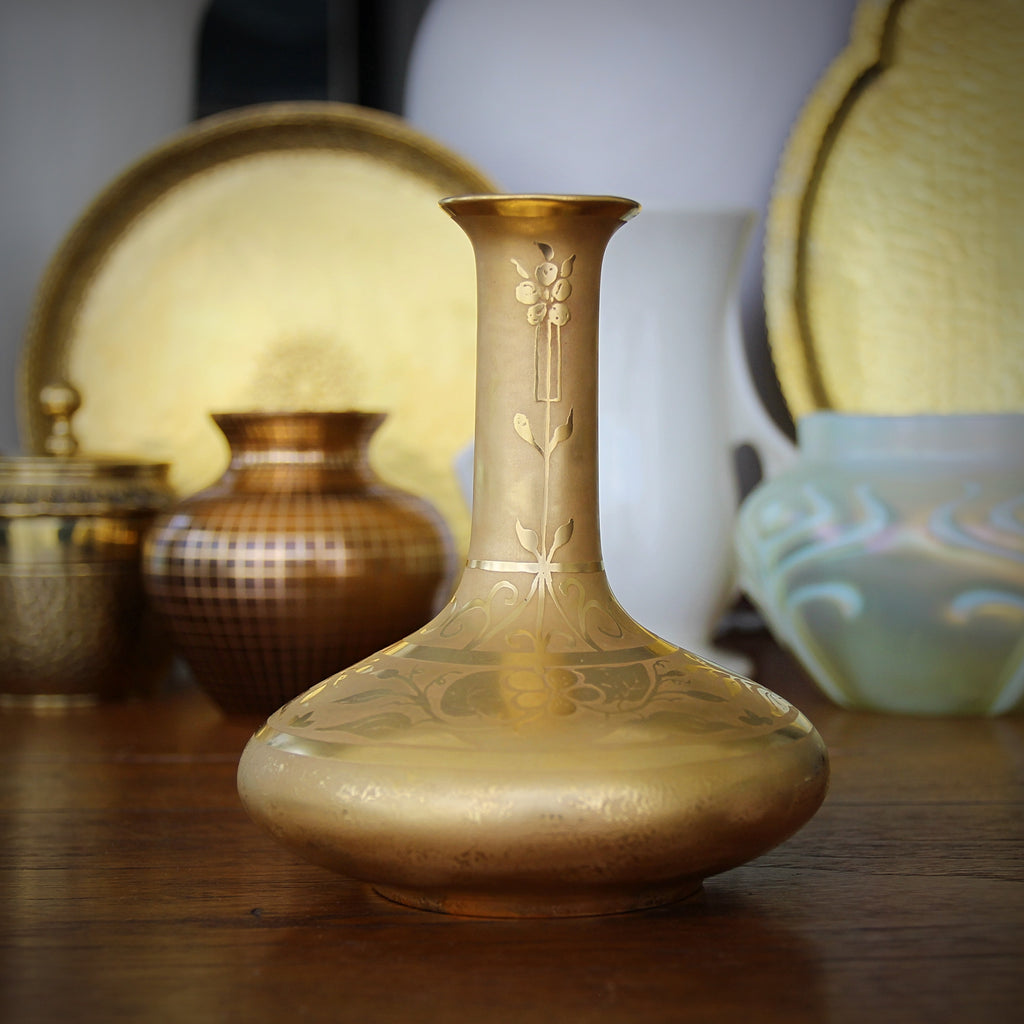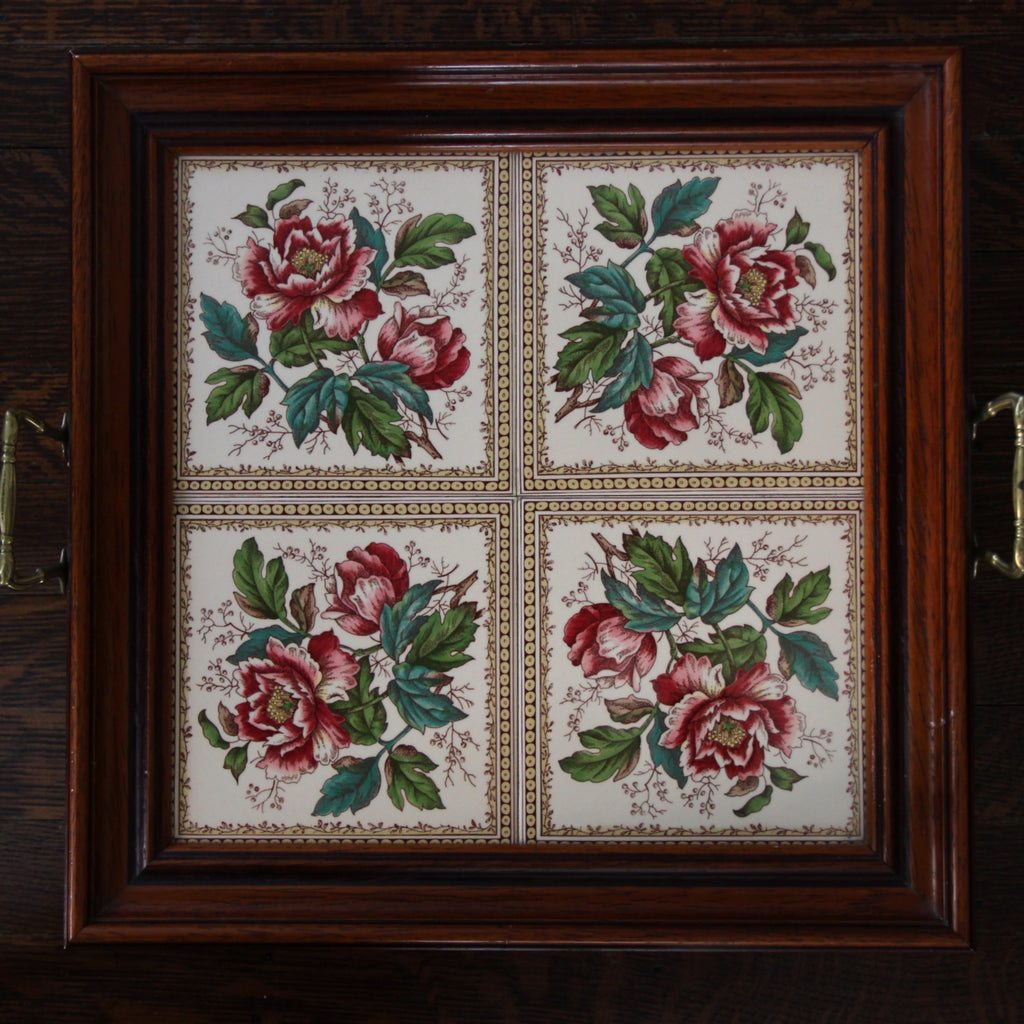JOURNAL — Art Pottery RSS
Here is another bear sculpted by our Danish friend, Knud Kyhn (1880-1969). This large, heavy and compactly-modeled form catches the startled expression and ursine energy of a lumbering bear. Is she just sitting down? Or trying to get-up?
Knud Kyhn often glazed his pieces in Royal Copenhagen's "Sung Glaze." This dripping blend of colors—browns, creams, blues, greens and oranges—has an earthy, organic and highly-variable appearance. The glaze was developed by Patrick Nordström, a brilliant ceramicist, who distinguished himself through his mastery of complex glazes. His Sung Glaze was inspired by earlier Chinese glazes—which had been intriguing the Western world for centuries.
Bearing with It - One
So much going on! And the year's only a week old! As for me, I'm bearing with it as best I'm able. So let's bear it together! This week we present a selection of handsome bears, all currently in-stock at LEO Design. Knud Khyn was a Danish artist born in 1880. He worked in various media, although, the lion's share of his work was creating stoneware sculpture—and most of his career was working for Royal Copenhagen (during the Art Nouveau, Art Deco and Danish Modernist periods). As one of Royal Copenhagen's premier artists, Khyn designed numerous sculptures in his signature style—mostly wild animals and the occasional mythical creature. Knud Kyhn would sculpt the original models, then supervise their subsequent moulding...
Will Democracy Fight Back?
There's a vicious demon prowling the world—devouring Democracies where they still remain. Even some countries which once proudly boasted of their Freedom—countries whose soldiers fought and died to preserve Democracy—are threatened by malignant actors. Alas, too many citizens (and their political party) are content to stand-by silently, watching Democracy be dismantled and Authoritarianism embraced. This assault is happening in all "corners" of the World.
Today is J6—a day when Democracy-loving patriots must recall just how close the country came to Authoritarian domination. It's a lesson worth contemplating. While that one-day endeavor did not (immediately) succeed, its goal is slowly and incrementally being realized—one Democratic building block after another.
A Belated Welcome: January!
January is here and she brings her handsome birthstone, the Garnet. Garnets are not the most exclusive of stones. In fact, some consider them "a poor man's ruby." But I have always loved the dark, red color of the stone. And I like the way that garnets are often assembled—en masse—within gold Bohemian settings (a style called "pavé" in which many small stones are cobbled together, like paving). Garnets are actually a range of stones with differing compositions. They are most often recognized as deep red, though many other colors can be found. Blue garnets are the rarest variety. Garnets are mined in India, Sri Lanka, Myanmar, Russia, Africa and Madagascar, and within Canada and the United States. Some "species"...
A New Year
Each New Year offers the promise of change: improvement, recalibration, redemption. Most years, my resolutions have been centered on selfish personal development (usually diet and exercise). Maybe this year.
In these past few years, each New Year has begun to provide me also a glimmer of optimism: perhaps this will be the year where our country (and the world) turns a corner, does right, embraces goodness, and seeks redemption. Maybe this year?
May you have a New Year of health and happiness. May good things happen to you and to those you care about.
And thank you for your support of LEO Design over the past year.
And Five Days 'til Winter!
You mean Winter hasn't even started, yet? No, alas, Winter still is five days away! Yet the wintry blast is upon us. I've shoveled (twice) and already pulled-out my fake-fur hat ("hat hair" be damned—I usually wait much longer to submit). It is cold and icy and Pittsburghers already are cancelling their plans—whether joyous or obligatory. I don't remember "The Snow" posing such a threat to New Yorkers. In New York, one cannot easily avoid the meteorological elements (or other New Yorkers). One must leave the apartment, alight the sidewalk, and walk (outdoors) to the store, to work or to the subway. Snow (or "pending snow") never seemed to affect New York denizens—with the exception of generating a surge in Chinese...
World Aids Day
Today is 1 December, World AIDS Day. It is a day when the world advocates for the prevention and treatment of AIDS—and encourages scientific research to achieve those worthy goals. World AIDS Day was established by the World Health Organization in 1988 with the intent of recognizing the scourge of AIDS, commemorating those who have died from it, and supporting those who live with it.
While much of the world commemorates World AIDS Day today, (the current) U.S. leadership has instructed government officials to cut AIDS research funding and to not acknowledge the observance publicly. Somehow, they assert, America does not care about AIDS.
Autumn in New York - Part Eight
We've always loved ceramics at LEO Design—in every form: vessels, plaques, sculpture or architectural elements. Today we'll share a handful of interesting ceramics pieces from around the world—all in the collection of the Metropolitan Museum of Art. Shown above, an Eighteenth Century porcelain lion. He was made around the year 1732 by Johann Gottlieb Kirchner in Meissen, Germany (about 15 miles from Dresden and 60 miles from the Czech border). This lion was part of a series of large porcelain beasts created for the Japanisches Palais in Dresden. The palace was built in 1715 and expanded shortly thereafter to house the Japanese porcelain collection of King Augustus the Strong. (Collecting Asian ceramics was the rage amongst European aristocrats in the...
All Hallows' Eve
Today is Hallowe'en, Day One of the three-day "Allhallowtide": Hallowe'en (31 October), All Saints' Day (1 November) and All Souls' Day (2 November). All Saints' Day and All Souls' Day are two important celebrations in the Church—commemorating "the faithful departed" (first, for those we know to be saints and, second, for those we don't know, yet). All Saints' Day was first celebrated in 609 AD. The date was later moved to 1 November (in the 730's AD), where it remains to this day. In recent times, the vigil on the night before All Saints' Day (Hallowe'en) has taken-on a secular dimension. Today, children dress-up in costumes and go door-to-door, asking for treats. But the following day, All Saints' Day, is still an...
Welcome, October!
Welcome, October, and your birth flower, the marigold. Marigolds comprise dozens of species in the Tagetes genus. The name, "Mary's Gold," is a reference to the Virgin Mary.
Marigolds originated in Mexico and eventually spread South into Central and South America. This pungently-scented plant has been used medicinally, sometimes drunk as a tea, and it is also employed as a culinary herb or food colorant. In South Asia, marigolds are used decoratively—strung into garlands, decorating shrines, or arranged as a carpet—for celebrations and Hindu religious ceremonies. In Catholic Mexico, marigolds are featured in "Day of the Dead" festivities or used to decorate the freshly-cleaned graves of deceased loved ones.
A Dark Horse
In the world of horserace gambling, a "dark horse" was an unknown or unfamiliar racehorse about which gamblers knew little or nothing with which they could strategize their bets. In the 1830's, the term was expanded to include any kind of competitor—in sports, business or politics—who comes out of nowhere (surprisingly) to win the contest. The ceramic "dark horse" bookends, shown above were made in the 1930's or 1940's by Abingdon in Knoxville, IL. Abingdon was a successful maker of durable, high-end plumbing fixtures: sinks, toilets, water fountains. They used a proprietary blend of quality clays, a dense, "vitreous china" which was highly chip-resistant. Abingdon was known for its fantastic glazes and was the first company to offer products in...
If You Can Keep It . . .
It was on this day in 1787 and Benjamin Franklin was leaving the Pennsylvania State House in Philadelphia (now called Independence Hall) where the Constitutional Convention members had just voted to approve the US Constitution—and to send-it-onward to the states to be ratified. Elizabeth Willing Powel, the wife of Philly's mayor, asked him, "Dr. Franklin, what sort of government have you given us?" Ben Franklin responded, "A republic madam, if you can keep it." For 249 years, our democratic republic has served America admirably—certainly imperfectly at times, but (generally) improving with every passing decade. The alternative to a democratic republic would have been a monarchy—and the Founding Fathers decided that America must reject an entitled autocrat, gorging himself on plunder...
More Sapphire - IV
Here's another stunning piece by Wendelin Stahl, made in the Fifties or Sixties. This heavy, slab-form piece is pure sculpture—and a statement piece, wherever it may be placed. But it's the masterful glazing which makes the piece exquisite. An organic, taupe glaze flows down the sides of the piece, over a stunning sapphire crystalline glaze. The juxtaposition of brilliant, heavenly glazing on such a heavy (perhaps Brutalist?) form gives this piece an aesthetic tension: the delicate balanced with the brutish. Beauty and The Beast.
More Sapphire - II
Wendelin Stahl was born in 1922 in Höhr-Grenzhausen, Germany. He was born into a family of skilled ceramicists and worked in his father's studio. After World War II (and after art school where he studied ceramics), he and his wife, ceramicist Else Harney, founded their own studio. Their workshop was in "Burg Coraidelstein," the medieval castle in Klotten. Stahl experimented with elegant, Modernist forms—glazed with complex, beautiful glazes. Stahl allowed other artists to display their works alongside his pottery. Many consider him the finest of German Modernist ceramicists. Shown here, a high-shouldered, cylindrical vase with organic, dripping glazes. A metallic, gunmetal-mushroom glaze runs down over a vibrant, sapphire blue crystalline glaze. The piece is classic and Modernist at the same...
Antonio Canova and His Lion
Let's say farewell to August with this handsome and impressive lion, modeled after The Vigilant Lion sculpted by Antonio Canova in the late Eighteenth Century. Antonio Canova (1757-1822) grew-up with marble dust in his veins. He was sculpting as a very young boy. He was born in Possagno, Italy (outside of Venice), and lost his father (who was a stonecutter) when he was four years old. He was taken-in by his grandfather, a stonemason and owner of a quarry. Canova's grandfather sculpted marble altars in the Late Baroque style. By the age of nine, young Canova was modeling clay and carving marble. At 12, Canova began a two year apprenticeship under Giuseppe Bernardi. He then worked under Giovanni Ferrari before...
Roseville
Roseville's ceramics legacy is divided into several different "periods" of output (Early-, Middle-, and Late-) and their highly-varied design lines over many years. The company began in Roseville, Ohio, in 1890, making "utilitarian wares": crocks, flowerpots, cuspidors. In 1898, Roseville purchased a larger ceramics factory in Zanesville, Ohio (some 10 miles away), and, by 1900, had expand into a range of higher-end, hand-painted art wares. Designer Frederick Rhead joined the company as Art Director (1904-1908) and had an enormous impact on "aiming" the company in the right direction. Frederick's brother, Harry Rhead, took the reins in 1908 and created several profitable lines. Then, in 1918, Frank Ferrel became Art Director (for the next 30 years) and oversaw the explosive creation...
Pottery Illustrates Humanity
From the earliest human civilizations, ceramics have been one of the most important signifiers of mankind's ingenuity and aesthetics. Indeed, shards of pottery—sometimes painted, sometimes carved—are amongst the most illuminating remnants of an ancient culture. Pottery was used both functionally and decoratively. It was used to hold liquids: water, wine, oil. It could be used to store foodstuffs: olives, spices, salt. And it could be used ceremonially: in religious or funerary rituals. But ceramics also have been made for strictly aesthetic reasons. And the finest works—wherever in the world they were made—were highly coveted by those who could afford them: monarchs, warlords, industrialists.
Marblehead
In 1904, Dr. Herbert Hall opened a "handicraft shop" at his sanatorium in Marblehead, Massachusetts. His goal was to provide occupational therapy—woodcarving, weaving, metalwork, ceramics making— for female patients committed with "nervous disorders." He believed that creative work would have a curative and "normalizing" effect upon his patients. Arthur Eugene Baggs, an 18 year old ceramics student from Alfred University (in Western New York State), worked with the Marblehead patients during his summer break in 1905. At the end of the summer, when he should have been returning to school, Baggs was induced to stay permanently—to "professionalize" and manage the hospital's ceramics studio. Alas, most of the patients did not possess sufficient talent to produce high-quality wares and, in 1908,...
Summer Skies
Is there anything more beautiful—more pristine—than a lovely summer sky? Whatever the shade of blue, whether with clouds or without, nothing is more perfect than a bright, heavenly-blue firmament. These sky blue candlesticks were made outside of Manchester, England, by Pilkington Royal Lancastrian. The company had a very inauspicious start. In 1889, the four Pilkington Brothers began to dig for coal along a new seam in Clifton, Greater Manchester. They found no coal; all they got was clay! At first, they attempted to make bricks, but the "marl" they uncovered was not ideal for that use. The secretary of the coal company happened to know William Burton, a chemist at Josiah Wedgwood, which was a successful, 130-year-old ceramics factory in...
Happy Independence Day!
On this day in 1991, Kiev adopted the Ukrainian Declaration of Independence, proclaiming its freedom as a separate, sovereign and independent nation. In February of 2014, Russia invaded Ukraine, occupying Crimea. Russia escalated its attacks on the rest of the country in February of 2022. Today, Ukraine is fighting to defend its independence. It is fighting for its very existence. All good people who believe in Democracy and the Rule of Law must support the Ukrainian underdog. Appeasement of dictators never ends well. And dictators, once emboldened, rarely stop their oppression. Slava Ukraini!
Bird Watching - VI
Built for speed, the peregrine falcon is the fastest animal on Earth, having been clocked diving at 240 miles per hour. They have been long admired by humans—sometimes worshipped as a god (as the Egyptians did) or domesticated and trained as treasured hunting and sporting companions (in the Arab Middle East). I recall an incident in 2017 in which a Saudi prince purchased 80 airplane seats for his 80 falcons. I have even heard that some falcons have passports, which allows them to travel across international borders with their keepers. Peregrines are found all over the world except in extreme polar regions, in very high mountains, or in tropical rainforests. They even have been known to live in cities which...
Bird Watching - II
Nils Thorsson (1898-1975) was a Swedish-born ceramicist who worked for—and greatly influenced—the Royal Copenhagen ceramics workshops, especially during the Modernist boom following World War II. Royal Copenhagen was founded in 1775 and had already reinvented itself several times in the past. However, to position Royal Copenhagen for success after the War, Thorsson recruited to his Aluminia Fajance division (in 1958) a group of six young women—Scandinavian ceramics designers from Norway, Sweden and Denmark. One of these women was Beth Breyen. She was Norwegian and a student from the National Craft and Art Industry School in Oslo (1956-1960). Nils Thorsson worked with Beth (and the other women) to develop the Tenera line. He allowed each designer to see where her inspiration...
So Much Sun - V
We call "our star" The Sun. Others call it the Sunne, Sünn, Sonne, Sinne, Sunna, Sunnō, Sauil, Slunce, Sōl, or Sól. The Greeks call it Hēlios and the Welsh call it Haul. For billions of years, the Earth has been flourishing thanks to the Sun's heat and light—which takes about eight minutes to get from he Sun to the Earth. We end our parade of "Solar Ceramics" with this handsome and imposing piece by Pilkington Royal Lancastrian. It was made in England in the Twenties or Thirties. It wears the handsome "curdled" glazes—yellow and orange—which have inspired this week's exploration of the Sun. It would make a substantial impact in your home, either standing alone or centering a collection of...
So Much Sun - IV
Scientists tell us that the Sun is approximately 4.5 billion years old—nearly half-way through the "Main Sequence" of its lifespan. It has another 5 billion years (more or less) of hydrogen to burn, similar to the way it burns now. When the Sun no longer has enough mass remaining to stay tightly-compact, it will expand enormously, becoming a "Red Giant"—swallowing Mercury and Venus and making the Earth too hot to be habitable by living organisms (eventually swallowing-up the Earth, too). After the Red Giant burns-up any of its remaining fuel, it will contract into a hot, small, White Dwarf—no longer generating new heat but undergoing a long cooling process (over trillions of years) into a Black Dwarf, which will continue...
So Much Sun - III
The Sun provides the Earth's heat and light—without which, the Earth could not sustain life as we know it. Without the Sun's radiant heat, the Earth would freeze in space's frigid atmosphere. Without light, the Earth's plants could not grow—which provide oxygen and food for other creatures. The Earth's orbital track is the perfect distance from the Sun, beautifully situated in a "sweet spot" that is not too close, not too far. Of course, the seasonal tilting of the Earth (from winter to summer) has an enormous effect on regional temperatures and light. Even this small amount of difference (in distance from the Sun) can make a big difference in regional conditions. Imagine if the Earth's entire orbit were to...
So Much Sun - II
What is the Sun? How was it made? Scientists have spent lifetimes studying, contemplating, speculating, and advancing our knowledge of the Sun. For millennia, the Sun has been a frequent object of human veneration—sometimes even worshipped as a god—by societies who recognized its life-giving force, without which life on Earth would cease. In a nutshell, the Sun is a star—the biggest, brightest and hottest object in our Solar System—around which Earth (and other planets) orbit. The Sun (and the Solar System) was formed when an ancient "Molecular Cloud" began a process of "gravitational collapse," probably triggered by another star's violent explosion. Most of this material (99.86%) rushed to the center, forming the fiery Sun. The remaining few bits (0.14%)...
So Much Sun - I
Is it me? Or is Summer somehow more . . . brutal . . . than I remember? Sure, we've all grown accustomed to the comforts of air conditioning. But this Summer has seemed continuously hotter and drier than the previous Summer (or the 50 Summers before that). In the past, the occasional summertime hot spell was interspersed with more moderate, sometimes cool-ish (and rainy), periods. Now it just seems always to be hot and dry. My little garden has been savaged. My tiny patch of grass is brown. The Sun—that flaming, molten ball of fire in the sky—seems to be more threatening than ever. Climate change and man's damage to the atmosphere add greater alarm. Over the next...
Countdown to LEO - 4
From the point-of-view of the lion, the story of Young Hercules and the Lion is rather chilling. But it is a classic and bears repeating. In Greek mythology, the Young Hercules—before he became the superhero we know today—was assigned Twelve Labors by his uncle, King Eurystheus of Tiryns. Hercules was being challenged as penance for having killed his family after the goddess, Hera, drove Hercules mad. (She was trying to get back at Hercules's father, Zeus.) The Labors were intended to be impossible for the Young Hercules to accomplish. Hercules's First Labor was to kill the Nemean Lion. Nemea was a village about 20 miles southwest of Corinth. The fearsome Nemean Lion was invincible due to its beautiful golden fur,...
"It Must Be Jelly . . . "
Fruit preserves are made all over the world. They contain endless combinations of ingredients—sweet fruits, savory fruits, sweeteners, spices—and go by many different names. In America, we tend to think of "jam" as a sweet fruit preserve, which still contains chunky bits of fruits (sometimes a little fruit, sometimes a lot of fruit). Jelly, on the other hand, usually refers to a clear (strained) fruit concoction which has been gelled. Good jellies "quiver" when shaken, while maintaining their form and they can be cut cleanly with a knife (and still hold their shape). More than one song from the Thirties and Forties included the phrase, "It must be jelly 'cause jam don't shake like that!"
One Day More!
As they sing (vigorously) in Les Miserables, "One Day More!!!" Tomorrow the French celebrate La Fête National (Bastille Day).
The covered ceramic urn, shown above, is a celebration of French Art Nouveau style. Botanically-inspired, randomly organic, and hand-crafted beyond reproach—this piece, made by Denbac around 1910, is the poster child for handsome Art Nouveau aesthetics.
In its day, it might have been created to hold tobacco. But it could be used for many other things. A place to keep spare house keys. A jar to keep paperclips on the desk. Or even a fitting place to keep the remains of a beloved (small) pet
Fulper Pottery
When it comes to art pottery manufacturers, some were high-end—with artful glazes and costly hand-finishing—while others sought to mass-produce an attractive product, attractively priced. Fulper Pottery, from Flemington, New Jersey, was one of the high-end, high-minded makers during the late Arts & Crafts period.
Fulper began (as many ceramics makers did) making utilitarian wares: stoneware crocks, tiles and plumbing pipes. Samuel Hill established his namesake company in 1814. His partner, Abraham Fulper, took-over in 1860, when Hill died. He renamed the company Fulper. By the Arts & Crafts period, his grandson, William H. Fulper II, was at the helm. He established the art pottery line, called Vasecraft, in 1909.
Faience
Although this pair of Nineteenth Century French faience vases are small, they punch-above-their-weight when it comes to hand-painted decoration. They were made in the third quarter of the Nineteenth Century.
Faience uses tin-glazes. The addition of oxide of tin to the paint gave the piece an opaque—usually white—base coat upon which other colors could then be applied. This tin-glaze effectively concealed the (usually red) clay beneath, thus "priming" the ceramic as a blank slate (ready for additional, fanciful decoration). This development was an important milestone in the evolution of ceramics- and tile-making.
July is Here!
Welcome, July, and your birthstone, the Ruby! Rubies are one of the four "cardinal" gemstones, alongside diamonds, emeralds and sapphires. In fact, rubies and sapphires are the same stone: Corundum. Chromium impurities within the mineral turn the corundum red; iron and titanium impurities turn the corundum blue. Otherwise, they are the same base gemstone. The name "Ruby" is derived from the Latin word "Ruber," meaning "red." The finest specimens, Pigeon's Blood Rubies, are mined in Burma. But rubies also have been found in Thailand, India, Cambodia, Afghanistan, Australia, Africa and South America. In the United States, rubies have been found in Wyoming and the Carolinas. Rubies are found in a pink variety, however, by law, such stones must be sold...
Art Nouveau, Creepy & Crawly
The Art Nouveau Movement—which we translate as "The New Style" or "The Modern Style"—came on the heels of the Nineteenth Century's "Great Leap Forward." It was a time of progress and increased understanding of science, discovery and critical understanding. At the Turn-of-the-Twentieth-Century, industry boomed. The Middle Class grew. And more people (for the first time) had a little extra money to spend on luxuries, rather than spend every last penny on necessities. This expansion of wealth and markets had an enormous effect on artists, designers, and those who employed them to create and produce merchandise for a growing Middle Class. Whereas, in the past, artists were "commissioned" to work for the "very few, very rich" patrons, artists were now...
Flower Frogs
A flower frog is a device used to assist in floral arranging. It helps to hold-in-place the stems which might otherwise shift out-of-place. Most often, one will see frogs used when arranging stems in a low bowl. With a taller vase, the high walls and "throat" of the vessel helps to consolidate the flowers. But arrangements in a bowl—especially when very few stems are used—can be much more challenging to affect the perfect look. It is believed that flower frogs originated in Japan in the 1300's. The Japanese dubbed them kenzan, which means "sword mountain." They were spiky, needle-like structures which were perfect for ikebana arrangements—in which very few (three? five?) perfect stems were positioned (perfectly) in a low, horizontal...
Happy Father's Day!
Happy Father's Day to all the men who helped to raise, teach and inspire children—men who provide(d) the best examples of self-discipline, integrity and kindness. Conceiving a child is the easiest step. So is letting someone else raise him or her. Growing a good, constructive and honest child is the hard part (and it is the part that counts). Shown here, a Danish Modernist stoneware sculpture by Axel Thilson Locher (1879 - 1941). He designed works for the Copenhagen ceramics studio Bing & Grøndahl. Locher was born in Copenhagen to an artistic family. His father was nautical painter Carl Ludvig Thilson Locher (1851-1915)—and Carl's father was a nautical painter before him. Both Carl and Axel lived and worked in Skagen,...
Countdown to Father's Day - 3
Now: something for the father who appreciates fine and good-looking . . . books. A pair of French terracotta bookends sculpted by Joe Descamps and produced in ceramic by Louis Lourioux. Joe Descamps (1869-1950), sometimes spelled Descomps, was a master sculptor who specialized in female nudes. His subjects were often placed in pastoral or floral settings. He worked in both the Art Nouveau and Art Deco periods (and, indeed, this pair of bookends seems to be "transitional"—that is, reflecting aspects of both aesthetic schools). Descamps also designed jewelry and metal sculpture. Ceramicist Camille Louis Lourioux (1874-1930) was born into a family of potters. In his Twenties, he managed a ceramics workshop with his father. But he soon set-out on his...
Countdown to Father's Day - 5
Danish artist Knud Kyhn (1880-1969) was a master of capturing "animal energy" in his stoneware sculptures. His bears exhibit ursine energy. His cats express feline energy. And, naturally, his bulls channel bovine energy—as does the "Bull in Repose," shown here. The animal swings its heavy head—atop an impossibly thick neck—perhaps expelling the bothersome flies which have landed on his massive back.
Knud Kyhn worked for Royal Copenhagen for many years, hand-sculpting the original "models" (many of them animals) and supervising their production and glazing. Royal Copenhagen was in the business of producing "collectible" artworks, thus, they would produce a small number of each design every year—usually marking the bottoms of each piece with a date-mark.
Memorial Day
The idea of visiting the graves of loved ones—perhaps cleaning, tending or decorating them—is an ancient custom, observed the world over. Throughout history, towns, cities, states or countries may have designated a specific day on which this might occur. After the American Civil War, Union General John A. Logan called on all Americans to observe 30 May 1868 as a National "Decoration Day"—a day on which loved ones could visit and lay flowers on the graves of fallen Union soldiers. By 1890, each US state, North and South, had adopted 30 May as Decoration Day. In 1968, the US Congress "regularized" the date to the last Monday in May—which also created a three day federal holiday. And, in 1971, the...
LEO - V
Lions have enjoyed a long history in the decorative arts. This rampant lion—incised upon a Belgian Art Nouveau vase—looks like he could have come from Minoan Crete or Mycenaean Greece. It is true that ancient themes often have been "recycled" by later artists—especially after a new archaeological discovery is made, inspiring new takes on old artworks. This two-handled stoneware vase was made in Belgium by Antoine DuBois (1869-1949), probably around 1920. Initial excavations as Knosos, the remarkable palace on the island of Crete, began in 1877. Much archaeological progress was made in the earliest years of the Twentieth Century—right before this vase was conceived. Crete is considered, by many, the "cradle of Western Civilization." Crete's Minoan art and civilization (3000-1150...
Welcome, May!
Welcome, May, and your birthstone, the Regal Emerald.
Emeralds—one of the four "Cardinal Gemstones"—are called "The Jewel of Kings," and they enjoy a long and illustrious history. Egyptians mined them from 1500 BC and legend has it that Cleopatra decorated her body and her palace with the gemstone. They have been mined in Austria and India since the 1300's and, in 1535, were discovered by Spanish explorers in Columbia (which remains the largest source of emeralds to this day). Emeralds have been credited with increasing fertility, providing immortality, conferring riches, power and eloquence, strengthening memory, counter-acting poisoning or infection, and empowering its wearer to predict the future.
Thinking of Francis - VII
We end our tribute to Pope Francis—and the simple, elegant, white ceramics which remind us of him—with this handsome, Art Deco piece, circa 1935. It was made by Roseville, a ceramics workshop founded in Roseville, Ohio, in 1890. Initially, Roseville made "utilitarian wares" like flower pots and umbrella stands. Over the years, Roseville added dozens of "lines" of pottery, from the delicately hand-painted studio wares to the high-volume mass production wares. Roseville also made several pieces (shapes) which they produced as "blanks"—that is, bisque-fired pieces which could be stored for glazing (and possibly decoration) later, as the orders came in. This strategy allowed Roseville to maintain maximum flexibility, only committing to the production of a specific piece after it had...
Thinking of Francis - VI
We come back to Haeger Pottery with this Modernist piece, made in the Sixties or Seventies. It is a highly-architectural silhouette—with more than a passing resemblance to Frank Lloyd Wright's Guggenheim Museum on Fifth Avenue, New York City. Although it is firmly within the Modernist sensibility, there is still a trace of the "long tail" of the Art Deco movement (which began in the Twenties and lingered-on, evolving, yes, well into the Fifties and Sixties). It is finished with a matte white glaze.
Thinking of Francis - V
In 1886, German immigrants Thedore Ebeling and Frederick Reuss joined John E. F. Zeh (in Philadelphia) to import glass and ceramics items from Europe to America. In 1900, Zeh left the company, now called Ebeling & Reuss. The company imported European crystal, ceramics figurines, and art pottery pieces—like the Secessionist vase, shown here—to be sold-onwards to gift shops and other retailers in America.
This Secessionist vase is topped with three crisp handles and finished with a flat, matte white glaze. It was made in the newly-formed Czechoslovakia (established in 1918) and bears the date mark of 1918 - 1921.
Thinking of Francis - IV
This week, we are marking the passing of Pope Francis by sharing a collection of simple, white ceramics which (somehow) capture the elegant purity and honest simplicity of the beloved pontiff. Like Fulper Pottery in Flemington, New Jersey, Haeger Pottery began its life humbly. It was founded in 1871 making bricks, drain tiles, flower pots and tiles in Dundee, Illinois. In 1914, Haeger decided to establish a higher-margin artware division. Haeger hired-away ceramicist Johann Martin Stangl (from Fulper) to direct the new division. Thus began one of the highest volume mass-production ceramics workshops in America. Eventually, Stangl returned to Fulper (which he later purchased and renamed after himself). But Haeger continued to grow (and succeed) through the Art Deco and...
Thinking of Francis - III
So many ceramics manufacturers started their lives by making "sanitary ware" or even more utilitarian items like tiles and sewer pipes. Time and circumstances allowed these companies to adapt to the changing times, perhaps seeking higher-end, more profitable output. The Hill Pottery Company was founded in 1814 in Flemington, New Jersey. Around the time of the American Civl War, Abram Fulper purchased the company (renaming it "Fulper"). By the Turn-of-the-Century, his grandson, William Fulper II, was running the firm. In 1909, William Fulper created the art pottery division, calling it "Fulper Vasecraft." Fulper needed an experienced ceramicist to develop the cutting-edge forms and glazes of a "studio ceramics" workshop. He hired Johann Martin Stangl, an immigrant from Munich, Germany,...
Thinking of Francis - II
Abingdon Sanitary Manufacturing Company, founded in Knoxville, Illinois, in 1908, was the maker of America's finest "sanitary ware": sinks, toilets, water fountains. Their special blend of clays and high-heat firing methods created a "vitreous china" product that was beautiful, watertight, and resistant to damage. Abingdon was the first manufacturer to introduce colored plumbing fixtures to the market (1928). In 1933, Abingdon supplied all the plumbing fixtures to the Chicago's World Fair. The Depression was not good for the company; nationwide, most building projects came to a halt. Most of Abingdon's orders were cancelled. So, from 1934 to 1950, Abingdon introduced a line of "consumer" artware items—using the very same vitreous china and glazes that they used for their sanitary ware....
Thinking of Francis - I
This morning's passing of Pope Francis marked the end of a chapter of the Catholic Church. Francis was my favorite pope, in my lifetime—and many people (Catholic or not) were moved (and improved) by his call for Mercy.
Part of Francis's appeal was the conviction with which he side-stepped the enticing grandeur of the office. He could have dressed ornately. He could have lived in the opulent Papal Apartments. Instead, he chose to live in a modest apartment—alongside brother priests—and he dressed in the simple, white garments which represented modesty, purity and simplicity. This is not to say that Francis blended-in with a crowd. On the contrary, one always knew who he was and what he represented.
Good Friday
Ancient Jewish burial practices involved washing the body, anointing it with perfumes, oils and spices, and wrapping the body in linen. In the Good Friday Gospel accounts of Jesus's burial, it was the women who performed these rituals. Jesus's burial preparation was complicated by the fact that he died on a Friday afternoon, just as observant Jews were preparing for the pending Sabbath (which would begin at sundown). So Jesus was placed in the tomb quickly on Friday; the women planned to return on Sunday (after the Sabbath) to finish their work. The English Arts & Crafts two-handled pot, shown above, makes me think of the type of vessel (perhaps with the addition of a cover) in which the women...
More Light - V
Haeger Potteries began its life in 1852 as a utilitarian brick maker in Dundee, Illinois. They sourced their clay along the banks of the local Fox River, a tributary of the Illinois River. In 1871, David Haeger, a German immigrant, purchased half of the company. Within a year, he had purchased the other half. He began producing tiles and operated under the name Dundee Brick and Tile. The Great Fire of Chicago, in 1871, provided a tremendous opportunity for Haeger. The company shipped millions of bricks and tiles to help rebuild the devastated city. In 1914, David's son, Edmund Haeger, introduced "artware" (decorative consumer items) to the company's production line. Edmund recruited Martin Stangl from Fulper Pottery to oversee this...
More Light - II
Within the world of decorative arts, ceramics are amongst my favorites items. I also love decorative light fixtures (versus built-in lighting, like canisters and recessed fixtures). Light fixtures are like the "jewelry" which decorates a beautiful room. So, for me, this Mid-Century Modernist lamp tics two boxes at once.
This large ceramic "vessel" is finished with an organic, dripping "honey and mustard" glazing. Though of simple form, the large size—and the interesting glazes—elevate the lamp to the realm of "statement piece."
Spring Green - VIII
Let's end our Saint Patrick's Day "Parade of Green" with this handsome participant: an English Arts & Crafts vase by Pilkington Royal Lancastrian. The voluptuous and bulbous body is surrounded with a line of prehistoric "fiddlesticks," like the unfurled curls atop an emerging fern. The use of naturalistic, Darwinian—sometimes even grotesque—botanical elements is classic Art Nouveau.
Equal to the superb form is the sensational finish. The glazing is a dappled blend of green and blue—rich and deep. The complex glaze only adds greater intensity to an already highly-dimensional form.
Spring Green - VI
Sgrafitto is the Italian word for the technique of artistic scratching (from the verb graffiare—"to scratch"). This method may be used on plaster, on painted works, or (like with the vase shown above) on ceramics. After the ceramic piece is fired once—and a "bisque" form is obtained—it is glazed and allowed to air dry. Once dried, selected areas are scratched-away with a stylus, revealing the raw clay, beneath. When the glaze is fired a second time, the color—and the scratched-away design—become permanent.
The sgrafitto technique was popularized in Renaissance Italy, especially on the ceramic (tiled) surfaces of grand buildings. The technique later became popular in Persian ceramic craft.
Spring Green - IV
Reginald Guy Cowan (1884-1957) was born into a family of ceramicists in East Liverpool, Ohio (itself a major center of ceramics production). He studied at the New York State School of Clayworking at Alfred University (in Western New York). After school, he settled in Cleveland where, in 1908, he introduced pottery-making in the public schools. He also began teaching ceramics industry at trade schools and was an instructor at the Art Institute of Cleveland. Eventually, Cowan opened his own pottery workshop, the Cleveland Pottery and Tile Company in Lakewood, Ohio—a "street car suburb" of Cleveland, on Lake Erie. Cowan's architectural tiles, used throughout the Greater Cleveland area, paid the rent. But he also produced a small range of decorative "artware"...
Spring Green - III
Earlier this week, I expressed my love for matte green Arts & Crafts pottery. I find the shade so relaxing and natural—reminiscent of tree leaves upon oaken furniture branches. Matte green hues extend the full range from the pale to the ultra-saturated. The matte green of the Weller Arts & Crafts vase, shown above, hits the color range dead center. And it is possibly the finest piece of matte green pottery I have ever collected. This vase was part of their "Bedford" line from the early Twentieth Century. The tall, cylindrical form is buttressed and footed—and robed in a luscious matte green glaze. One can see the incised floral decoration, underglaze, near the top of the vase.
Spring Green - I
Saint Patrick's Day has put me in a green mood. That and my increasingly greening garden. For the next several days, we'll be sharing some of our handsome green items—sure to put you in a vernal mood—all currently in-stock in the LEO Design on-line shop.
One of the first collections I assembled, in my first months after opening LEO Design in 1995, was a grouping of matte green Arts & Crafts pottery. I barely knew what it was or how it fit within the history of decorative arts. But I knew that I liked it. And I still do.
Shown here, a most-handsome Arts & Crafts jardiniere.
Saint Patrick's Day
Saint Pádraig, the patron saint of Ireland, was from a Roman-era British family, born in (it is speculated) 385 AD. His father was a deacon and his grandfather a priest. At sixteen, Patrick was kidnapped and shipped as a slave to Ireland where he spent six years as a shepherd. In his Confessio, his spiritual autobiography, he recounts a dream in which God instructed him to escape and head for the coast where a boat would be waiting for him. He did as he was instructed and returned to Britain where he joined the seminary, preparing to take holy orders for the priesthood. In 432, now a bishop, Patrick returned to Ireland, answering a calling to convert the Irish pagans...
Horse Sense - VIII
This week we are sharing some of our favorite Horse-themed Bookends at LEO Design. Earlier this week, we shared a pair of black vitreous porcelain horse head bookends made by Abingdon (Knoxville, Illinois). Shown above are a white pair—also made by Abingdon—which are equally stately, equally handsome.
Horse Sense - IV
The Abingdon Sanitary Manufacturing Company was founded in Knoxville, Illinois in 1908. They made very high quality plumbing fixtures: toilets, sinks, water fountains and other "sanitary ware." Abingdon's products were made of "vitreous porcelain"—a very heavy, dense, porcelain ceramic, coated with glass-like enameling which made the piece durable, impervious to damage or staining, and easy to clean. The company was regarded as the best in the business. They were the first company to introduce colored plumbing fixtures in 1928. And, in 1933, Abingdon provided all the plumbing fixtures for the Chicago World's Fair. Alas, during the Great Depression, the building industry was hard hit. Orders for plumbing fixtures dried-up. So, in 1934, Abingdon began producing decorative consumer goods (with the...
Welcome, March
We welcome, March. And we welcome your flower, the Daffodil—surely a most-welcome sign of a pending Spring! Daffodils are part of the Narcissus genus which are members of the Amaryllis family. They first grew some 33 million years ago, on the Iberian peninsula, from which they spread throughout Southwestern Europe and into North Africa. They became very popular in Europe in the 1500's and were extensively developed in the Netherlands shortly thereafter. Thousands of "cultivars" were developed through selective breeding. Long known to be poisonous (thus, deer won't eat them), they have been used medicinally since ancient times. Today, they are being studied as a possible treatment for Alzheimer's Dementia. But please be careful; their chemical components can have dangerous...
Birds of a Feather - VII
Beth Breyen was one of six young, female designers, recruited by artist Nils Thorsson, to come work for Royal Copenhagen in the post-WW2 era. She was born in Norway and studied art in Oslo (form 1956 to 1960). Thorsson developed the Modernist Tenera line at Royal Copenhagen and allowed his young design staff artists to contribute their own ideas to the various items within the range. Beth Breyen seems to have been inspired by fluffy—perhaps slightly demented—birds. It is a recurring theme in her work. This ceramic plaque, made in the Sixties or Seventies, shows a pair of birds (is it a mother and a chick?) standing against a rich blue background. It was sculpted by Breyen and produced jointly...
Birds of a Feather - II
The peregrine falcon in the fastest animal on Earth—at times achieving speeds of 240 miles per hour (while dive-bombing prey). Their athleticism, ferocity and trainability have made them useful to humans. Falconers have been working with peregrine falcons for 3,000 years. And the birds' hunting prowess (and noble appearance) have made them an iconic symbol of divinity, royalty and military strength for millennia. The Egyptian Sun god, Ra, was portrayed as a man with a falcon's head.
The Danish Modernist falcon, shown above, was sculpted by Knud Kyhn for Royal Copenhagen. It is dated 1967. It captures the hunter in a moment of watchful rest.
It's Showtime!
This year marks the 30th anniversary year of LEO Design. And—in all that time—we have never participated in an antiques show. I guess that I have always rationalized that, since I pay so much rent (and I lived in a city of 8.5 million people), why should I schlepp heavy and delicate merchandise miles away to set-up a folding table in a booth? What could I achieve in a weekend in a booth that I couldn't achieve over a weekend in my Greenwich Village shop? Finally, a change! Today—in our Thirtieth Anniversary Year—I will exhibit in my first antique show ever! Deciding what to bring was the first big task. Then, packing it—smartly and compactly—came next. I intended to only...
Countdown to St. Valentine's Day - 1
Tomorrow is "the big day"—St. Valentine's Day. We're sharing some of our favorite "reds" this week. Perhaps one of them will make the perfect Valentine's Day gift for a much-deserving sweetheart? Wars have a way of defining and separating the aesthetic movements which flourished before and after the conflicts. After World War Two, the world was ready to move-on from the Art Deco which had characterized the period between the wars. Mid-Century Modernism would become the fresh, new look—a signal that the world was moving-on, into the future. Wars also have an impact on people, institutions and companies. What worked before (or during) a war, may not succeed once the conflict has concluded. Italica Ars was formed in 1948—just after...
Countdown to St. Valentine's Day - 3
When it comes to pottery, which factor is more important: form or glaze? In truth, both are consequential. But, if I were forced to choose only one of them, I would have to say that the glazing is most important. Form can be easily copied. A ceramicist can easily make a mould based upon the shape of another artist's finished piece. In fact, pottery factories would sometimes sell their discontinued moulds to competitors. Glazes, however, are much more difficult to decipher and control. A small variation in glaze ingredients, their application, kiln temperature, firing time, or cooling process can result in significant differences in outcome. And the process of figuring-out (and then duplicating) a new glaze is filled with numerous...
Countdown to St. Valentine's Day - 5
With St. Valentine's Day on the horizon, let's look at some of LEO Design's suitably-red offerings for the February holiday.
Shown above, a handsome West German Modernist jug-form vase by Töpferei Hartwig Heyne. The firm was founded in 1850, during the Prussian Empire, in Silesia—along the Polish border. After World War Two, much of Silesia was transferred to Poland under the terms of the Potsdam Agreement. At this point, Hartwig Heyne's descendants—Christine Heyne and her aunt, Meta—re-started the company as a smaller, studio pottery workshop in Oer-Erkenschwick, Western Germany. This move coincided with the emergent Modernist aesthetic, soon to become the most important interior design trend in the post-war West.
Feeling Blue - IX
We end our exploration of America's Blues with this substantial and handsome Italian immigrant (make that "import")—a Bitossi ceramic ashtray. Bitossi family members had been active in ceramics-making—on the outskirts of Florence— since the time of the Renaissance. Like many ceramics legacies, they started by producing "utilitarian" objects: roofing tiles, floor tiles, architectural trim. In 1921, Guido Bitossi founded the ceramics workshop we know today, venturing into artistic, decorative objets used to decorate the home. After World War Two, the company began a new chapter under the artistic leadership of Aldo Londi (1911-2003). He executed and oversaw Bitossi's production of Modernist ceramics—perfectly timed to catch the big, post war decorating wave. Londi designed product himself; he also hired cutting edge...
Feeling Blue - VII
In 1901, Grand Duke Friedrich II of Baden established a ceramics workshop in Karlsruhe—in the Southwest of Germany, along the French border. His aim was to promote craft and industry in the region. Over the years, the Majolika Manufaktur Karlsruhe produced quality works which represented the changing fashions of design: from the Art Nouveau, through Art Deco, to Bauhaus and Mid-Century Modern. One of their star designers was Friedegart Glatzle. She was born in 1920. After high school and technical (trade) school for ceramics, she was snapped-up by Karlsruhe upon graduation in 1951. Over a thirty year career with the company, she produced over 1200 moulds for Karlsruhe and was the leading design voice for the company. She also oversaw...
Feeling Blue - V
The color Petroleum Blue is a rather hard to pin-down precisely. An internet search suggests an overly broad range of bluish-greens. Furthermore, the name elicits a negative response in some—such are the environmental consequences of petroleum (especially when it has been spilled). But the color—which the Brits call Petrol Blue—is handsome, indeed. And the color did enjoy the embrace of shelter magazine hipsters five or six years ago. Broadly defined, petroleum blue is a blue-green with an emphasis on the blue. Perhaps the name poetically implies the elusive nature of the color—reminiscent of the unstable iridescence seen when petrol is spilled upon a floor or into a puddle of water. In any case, petroleum blue is a justifiably sophisticated and...
Feeling Blue - IV
This week we've been sharing some of our handsome blue pieces—an attempt to brighten the national "blue mood" as a bitter frost assaults our country. Let's hope for a change in the weather.
The simplicity of the English Arts & Crafts vase, shown above, belies the technical and aesthetic beauty of the piece. The voluptuous shape seems to curve sensuously in all the right places. And the softly-dappled cobalt glazing is simultaneously simple and complex, at once soft and bold. The form and the glazing are satisfyingly executed—whether the vase is displayed alone or within a larger group of ceramics.
Feeling Blue - III
When it comes to wintery glazing effects, this French Art Nouveau vase is really the icing on the roof. It was made by la Faiencerie Héraldique Artistique de Pierrefonds in the Teens or Twenties. The workshop was founded by the Comte d'Arros, Olivier de Sorra—a painter who wanted to produce ceramic wares in the village of Pierrefonds (about 50 miles northeast of Paris). After a slow start—producing "heraldic stoneware" with noble French crests—he landed upon the Art Nouveau stoneware with exceptional glazes for which he would forever be remembered.
The form is a simple, classically-inspired pot—with two little bumps, suggesting "handles" upon the rounded shoulder. A snowy-grey underglaze allows the organic, dripping overglaze to really pop.
Feeling Blue - I
An ill wind sweeps across America. I've been shivering for days. Others have been burning-up. How do we survive such a national calamity? There is no easy answer to such a question. For me, one thing is true: I'm praying for a change in the weather. True, the times are blue. Yet, blue can be so beautiful. Over the next few days, we will be sharing part of our "Collection of Blue"—currently in-stock at the LEO Design on-line shop. Let's make the best of the melancholy. Shown above, a West German Modernist vase, made in the Sixties or Seventies. It is squat in form, with a "volcano-form" neck rising from its crisp shoulder. And it is glazed in a sublime...
Winter White - XI
The satin white finish on this Art Deco vase is wonderful to hold and behold. It was made by Abingdon Pottery in Knoxville, Illinois, in the Thirties of Forties. Like yesterday's featured Horsehead Bookends, this Abindgon vase was made of uber-durable vitreous china, is finely hand-finished, and has a creamy-smooth satin white glaze. (Please see yesterday's Journal entry for more about the Abingdon Pottery Company.)
The silhouette of the vase is of classic, Chnese high-shouldered form. A series of ribs encircle the base and simple, Greek Key fretwork circumscribes the neck. It is a handsome piece—whether standing alone or arranged within a grouping—and very useful for flowers (the constricted neck holds-together a small handful of flower stems).
Winter White - X
These snowy white horse heads are bookends, nicely-sculpted and cast in highly-durable vitreous china by Abingdon Pottery (Knoxville, Illinois).
The Abingdon Sanitary Manufacturing Company was founded in 1908 and quickly gained a reputation for its beautifully-finished plumbing fixtures, made of ultra-durable vitreous china which was less susceptible to hairline cracking or chipping. In addition to superior (and expensive) clays, the company also spent a great deal of effort hand-finishing each sink, toilet, urinal, water fountain or bottled water dispenser. Abingdon was the first to introduce colored plumbing fixtures (in 1928) and were commissioned to provide all the plumbing fixtures for the Chicago World's Fair in 1933.
Winter White - VIII
Is anything ever really new? In the arts and aesthetics (at least), not as often as one may think. Artists, in all times, have taken inspiration from other artists (and artworks) which have come before. Take the Thirties vase, made by Roseville (Ohio), shown above. Its form—the body of the vessel—is a Classical Greek amphora shape, a silhouette used for thousands of years. Add to that the Art Nouveau "whiplash" handles—an aesthetic which was popular three or more decades before this vase was made. On top of this, we can perceive a Modernist Art Deco sensibility in the piece, despite the Ancient and the Art Nouveau elements. Somehow, all the old elements have been re-combined (by a talented artist) to...
Winter White - VI
Imagine scatterings of crystalline snow—granulated like sugar—blanketing patches of an otherworldly, volcanic-pumice mountainscape. That's what I see with this West German Modernist "genie pitcher" by Carstens. Full of texture and complexity—all within a tight palette of black and white (which creates grey). The Carstens family has a long history of ceramics-making, having operated workshops in Germany since the Nineteenth Century. Things really came to a boil during the early Twentieth Century, when Christian Carstens—along with his sons, Christian and Ernst—expanded the company broadly, buying smaller factories and setting-up new workshops. The company produced a wide range of porcelain, earthenwares and "sanitary ware" (that is, ceramic plumbing fixtures like water fountains, toilets and urinals) and was a top player in the...
Winter White - IV
Newly-fallen snow can look so pristine, so perfect. In fact, after a fresh snowfall, I often try to limit my footsteps to the same narrow path along the edge of my driveway—an attempt to maintain the largest possible blanket of snowy perfection. But such perfection is fleeting. (Perhaps a metaphor for life.) In time, the snow melts, wild animals scamper, and—sooner or later—I need to drive my car down the driveway. The brilliant white gradually becomes brown; the melting snow turns to slush and the earth below begins to dapple the winter white. What was once a lovely improvement has become a messy blight. (Perhaps a metaphor for life.) But that, too, shall pass: with the rising temperature, the slush...
Winter White - III
This creamy, satin glaze is reminiscent of a bank of snow. Shown above, an Art Deco ashtray made in the Thirties by Keith Murray for Josiah Wedgwood, Stoke-on-Trent, England. Keith Murray had a fascinating life—and he's one of the pillars of British Art Deco Modernism and industrial design. He was an architect, aviator, ceramicist, silversmith, and glass designer. Murray was born in Auckland, New Zealand, in 1892. He began his working life as a draughtsman for an Auckland architectural firm. His side passion was the pioneering field of amateur aviation and he was an officer in the Aero Club of New Zealand. When World War One began, Murray joined the English RAF and was deployed as a pilot in...
Winter White - I
While we're blanketed by snow, let us feature a few handsome pieces which channel the Winter's temperament.
Shown here, a West German Modernist vase by Ceramano (located in Ransbach-Baumbach, Germany, about 55 miles Northwest of Frankfurt). The workshop was founded in 1954 by Jakob Schwaderlapp, the same man who previously had established Jasba (in 1926). Jasba had always been a mass production-oriented operation, utilizing less artisan handwork (per piece) and generating a high volume of affordable output. After World War II, with the boom of post war Modernism, Schwaderlapp launched a new workshop in order to bridge the gap between expensive, high-touch studio production and the less expensive (but commonplace) mass production. Ceramano was the result of this mission.
The Epiphany
For some, January Sixth is a holy day: The Feast of the Epiphany. Theologically, it represents the moment when the Christ Child's divinity was recognized by the greater world (represented in the form of the three foreign Magi). The word, Epiphany, derives from the ancient Koine Greek "epipháneia," meaning "manifestation" or "appearance." The Epiphany is observed by most Christian denominations, though the date may vary based on the calendar system each particular denomination uses. For some Christians, Epiphany celebrations are bigger than those of Christmas. And the name, Epiphany, may be called "Theophany," "Three Kings' Day" or "Little Christmas."
A Clean Sweep
We finish our Winter Ablution with this forward-thinking creation. Even by today's standards—some ninety years after it was made—this piece still radiates Futurism. In the Thirties, space travel was still a dream. But all sorts of people—scientists, writers, artists—projected us into their imagined worlds of the extraterrestrial. Three decades later, in the Sixties, space travel finally was realized. Yet somehow, to me, those earlier, romantic notions of the future will always be a little more beautiful, dreamy and fantastical than the reality which followed. I suppose that artful conceptions are not limited by the realities of physics. And the Sixties Space Age was an exciting time. But I still prefer the Tomorrowland of the Utopian Future. The two-handled "flying...
A Clean Start
Let's continue our "clean start" to the New Year—with another piece of clean, matte white pottery from the Thirties. Shown here, a "paneled" Art Deco bowl finished in a satiny matte white. It was made by Roseville (at this point located in Zanesville, Ohio).
There's something about matte white pottery. It is fresh, elegant, immaculate. And the white coloration allows the form of the piece to shine-through without distraction. Of course, a collection of pieces—within a palette of whites—makes for a stunning (and clean) presentation in nearly any interior aesthetic. This smallish, compact piece would provide excellent punctuation along the front row of the assemblage.
Happy New Year.
Wishing all a Happy New Year of health, love and contentment. And a heartfelt Thank You to all who supported LEO Design in the previous year. Most years, I trot towards the New Year with optimism and gratitude—grateful for the fresh start, happy for a new beginning. Perhaps it's the turning of the Filofax, with its new pages so fresh and clean. Or could it be the cold, clear freeze—which has eliminated all traces of the previous season? No, not this year. Unlike in years past, I feel as though I'm being pushed unwillingly into this new year, forced into a new and dangerous era. But Time and Tide Wait for No Man. None of us can stop the clock. So here...
Merry Christmas
Wishing all—customers, friends, family, employees old and new—a Merry Christmas, Happy Hanukkah and a New Year of health and happiness. Thank you for your support of LEO Design this year! I hope our paths cross in 2025.
Ah, Houseguests!
Guests for the Holidays? Help keep their toothbrushes tidy with this Victorian English ironstone toothbrush caddy, made in the 1880's. The maker was Edge, Malkin & Company in Burslem, Stoke-on-Trent, England (the region of much Nineteenth-Century British ceramics production). The transfer pattern is called "Dacca," named after the Colonial Indian city (now Dhaka, Bangladesh). More broadly, the Dacca pattern satisfied the Western taste for Asian-inspired decor, especially in ceramics. The pattern fits squarely within the Aesthetic Movement of the Late Nineteenth Century. Ironstone is a type of pottery developed in England in the 1810's. It was a durable, hard-wearing, cheaper alternative to fine porcelain—suitable for mass production and ideal for decorating through transfer printing. Transfer printing, first developed in the...
The Winter Solstice
Today—at precisely 4:21 am Eastern Time—the Northern Hemisphere experiences the Winter Solstice. For those of us living above the Equator, 4:21 am is the moment of the year when the Northern Hemisphere will be tilted its farthest distance from the Sun. Today we'll see the shortest amount of daylight of the year, the longest amount of night, and it will be the first day of Winter. (In the Southern Hemisphere, today will be the longest day of the year, the shortest night, and the first day of Summer.) The best news: starting tomorrow, each consecutive day's period of daylight will be increasingly longer and longer.
"Transitional"
In the home furnishings industry—and in the decorative arts—the term "Transitional" is a convenient "safety word" to describe a piece which has the characteristics of two (or more) consecutive schools of design. It's often true that transitional pieces were created on the cusp of two significant, distinct movements. The vase above presents a good bit of Modernism (which was en vogue at the time it was made) and a little bit of Art Deco (from its recent past). To me, it is reminiscent of a softened version of Frank Lloyd Wright's Guggenheim Museum in New York. Like the building, the vase's "stacked," graduated segments get larger toward the top of the vase. Wright's museum was finished in 1959, after 15 years...
All Hallow's Eve
Tonight is All Hallows' Eve—more popularly called Hallowe'en—the first day of the Allhallowtide "triduum." Allhallowtide consists of three days: Hallowe'en, All Hallows' Day (also called All Saints' Day) and All Souls' Day. Essentially, Hallowe'en is the vigil, the night before the Holy Day of All Saints' Day (1 November). On All Saints' Day, all the saints are commemorated—both those whom we can name and those we do not know. 2 November is All Souls' Day—the day when all the faithful departed are commemorated. Since the early days of the Christian Church, various locales celebrated varying days for the commemoration of Christian martyrs. Later, this celebration was broadened to honor all the saints (martyred or not). In the Seventh Century, this celebration was expanded throughout...
The First Day of Autumn
Today is the First Day of Autumn. More specifically, it is the Autumnal Equinox. "Equinox" means "Equal Night." During an Equinox, the night and day are (roughly) of equal length. As we all know, the Earth rotates upon a central axis which tilts toward and away from the Sun (with the seasons). On the Equinox, the Earth's axis is perfectly aligned with the Sun—which places the Sun directly over the Equator. Today's Equinox (at precisely 8:43 am) marks the start of Autumn in the Northern Hemisphere and the start of Spring in the Southern Hemisphere. In the Northern Hemisphere, each day's length of sunlight has been getting shorter since the Summer Solstice of June 20th. Now, after the Autumnal Equinox, each day will...
The Last Day of Summer
"Summer afternoon, summer afternoon;
to me, those have always been the two
most beautiful words in the English language."
- Henry James
Yes, summer afternoons can be wonderful. Yet, alas, all good things must come to an end—including summer afternoons. Today, Saturday 21 September, will be our final summer afternoon until next year. Autumn will begin tomorrow morning.
Perhaps the two-handled vase, shown above, will serve as a reminder of endless, late-Summer afternoons. Though it was made in Mid-Century Germany, after World War Two, it clearly was inspired by Country French or Italian ceramics—perhaps a vase from Provence or Tuscany.
Friday the Thirteenth
In the West, Friday the Thirteenth is perceived as an unlucky day. It seems that this idea became widely popular in Nineteenth Century France. The earliest written reference to unlucky Friday the Thirteenth is a line in the 1834 play, Les Finesses des Gribouilles: "I was born on a Friday, December 13th 1813, from which come all of my misfortunes." That same year, the Marquis de Salvo wrote in the Revue de Paris about a Sicilian count who had killed his daughter on a Friday the Thirteenth. "It is always Fridays and the number Thirteen which bring bad luck." In America, it was T. W. Lawson's book, Friday, the Thirteenth (1907), which popularized the superstition on this side of the...
Labor Day
Happy Labor Day to the talented workers who—with the talent of their hands and the sweat of their brows—make our lives better and more beautiful. May they always be cherished and rewarded.
Shown above, a Danish Modernist stoneware tile—with deep bas relief sculpting—which portrays a blacksmith, hard at work at a hot forge. It was sculpted by Karl Otto Johansen for Danish ceramics workshop Bing & Grøndahl. It could be installed permanently within a larger tiling project or it can hang on the wall—all by itself—using the hanging grommet on the back of the tile.
211 Days . . . And Counting
211 days until Saint Paddy's Day! Thus, what better time to share this handsome Irish ceramic bowl, made in the Sixties. Modernist, indeed, but decorated with fascinatingly ancient (and timeless) Irish Celtic knots. This bowl was made by Wade (an English ceramics company) in its Irish workshop which opened in 1946 (in Ulster, Northern Ireland). The designer was James Borsey (1920-1977). The line, called "Celtic Kells," was comprised of six different pieces and was inspired by decoration in the illuminated manuscript, The Book of Kells (c. 800), which can now be seen in the Trinity College Library, Dublin. This line was made in very limited production runs—and only for a couple of years in the Sixties. Much of the production was...
A Tribute to "Cat Ladies" - V
There is a fine line between a feline's sense of play and her instinct to hunt. Cats—of every size, shape and variety—are known to be stone-cold killers. For this reason, keepers of house cats are strongly encouraged to keep their charges indoors all the time (for the sake of the billions of birds killed by American cats each year). When playing with a cat—with a laser pointer, a string, a paper bag or a retractable mouse—it is clear that her skill as a huntress is tied to her sense of play. Is your cat trying to "kill" her catnip mouse? Or is she only playing with the lizard in the backyard? (And why does she so often drop her "trophy" at...
A Tribute to "Cat Ladies" - III
Is there any greater luxury than an afternoon nap? Even if you're too busy to indulge in such a pleasure, you might enjoy watching this little kitty, curled-up, enjoying forty winks. He is made of stoneware, finished with a thick and curdled mocha-caramel glaze. He will happily serve as a little paperweight. Or be content to just lie-around, perhaps on the windowsill, making the place even homier.
Bastille Day
Are humans naturally drawn to Authoritarianism? Or, rather, do people yearn to live free? For centuries, historians and philosophers have studied various peoples living under monarchs, dictators and thugs. Why do some people prefer "to just let Daddy take over"? In 2024, we still do not know this answer.
Throughout history, there have been moments of people standing up to overwhelming Authoritarianism. Most of these moments have been bloody, deadly, and have spawned unpredictable results. Ultimately, history will be the judge of whether these revolutionaries are labeled "Patriots" or "Criminals." Remember: the winners write the history.
Welcome, July!
Welcome, July, and your handsome birthstone, the ruby! Rubies have always been amongst the most precious of "cardinal" gemstones—along with diamonds, emeralds and sapphires. In fact, rubies and sapphires are just different colors of the same stone: Corundum. This clear, hard stone is principally aluminum oxide. Different metallic "impurities" give the stone its different colorations. In the case of rubies, chromium is the impurity which makes it red. Corundum becomes blue (a sapphire) due to iron and titanium impurities. Both rubies and sapphires are very hard (which measure 9 on the Mohs Scale); only diamonds (with a hardness of 10) and moissanite (9.5) are harder. The most beautiful, valuable stones are used for jewelry. Lesser examples are used for watch...
Sun-Day
I cannot help but think of the Sun when I look at this cheery, Bavarian Jugendstil porcelain vase. A handsome Art Nouveau floral pattern peeks through the gilt glazing. It was made by Graf & Krippner in Bavarian Selb—in Germany, along the Czech border. Having been created so close to the Austro-Hungarian border helps explain the "Viennese aesthetic attitude" of the vase. The mark indicates it was made in the company's earliest years, 1906 to 1911. Selb is famous for its porcelain manufacture and is the headquarters of the Rosenthal manufactory. While the piece can be used to hold a stem or two, this vase is perfect for standing as punctuation within a collection of gold ceramics or glassware.
Summer First
Today, at 4:50 pm, Summer will have officially begun. Today is also the Summer Solstice, the longest day of the year—that is, in the Northern Hemisphere. It's the shortest day of the year in the Southern Hemisphere. As every schoolchild learns, the Earth spins on a vertical axis, an axis which tilts back-and-forth over the course of the year. On the day of the Summer Solstice, the North Pole (that is, the Northern axis), is tipped as close to the Sun as it will get. Thus, today, the Northern Hemisphere is receiving maximum Sun exposure (and the maximum number of hours of sunlight). Starting tomorrow, the axis will begin to slowly tip-back, away from the Sun, and the days' periods...
Welcome, June
June is here—with her flower, the Rose.
Roses have grown in the wild for tens of millions of years. 50-million-year-old rose fossils from the Eocene Period (which means, roughly, "The New Dawn") have been uncovered by archaeologists in Colorado. Roses are depicted in Minoan art (circa 1400 BC) and in Egyptian tomb paintings shortly thereafter. And ornamental roses are known to have been cultivated by the Chinese, Persians and Mediterraneans from about 500 BC. There are over 300 different species of natural roses and tens-of-thousands of man-made "cultivars" (that is, special varieties of roses purposely bred to accentuate selected traits like color, size, fragrance, form or hardiness).













